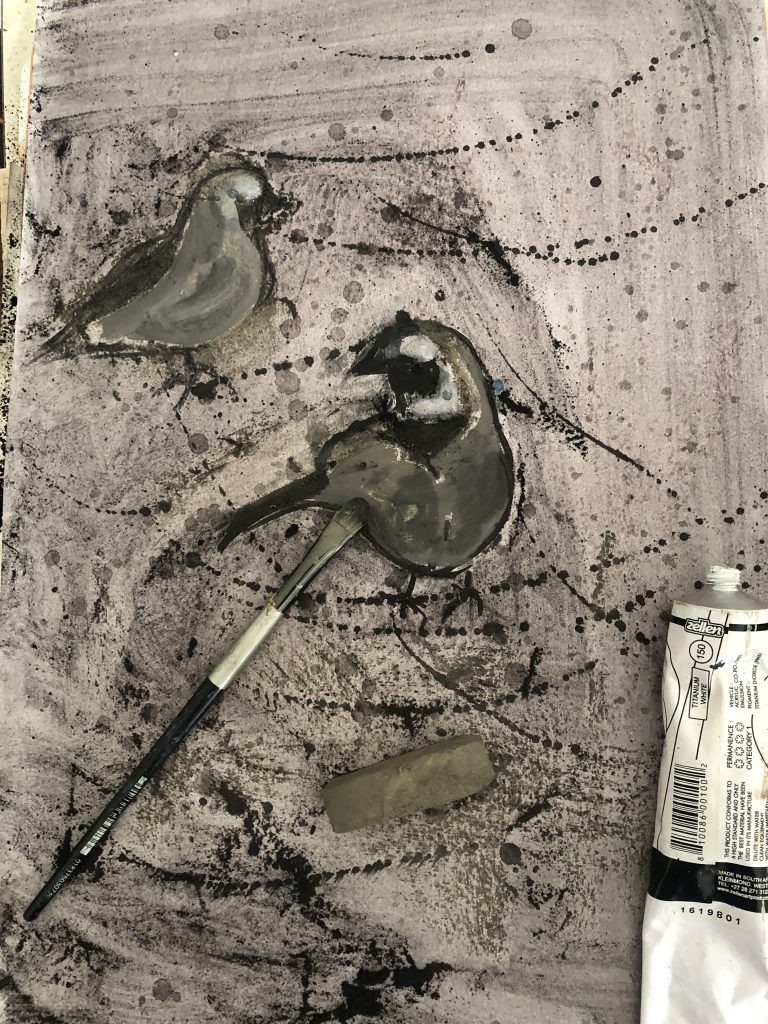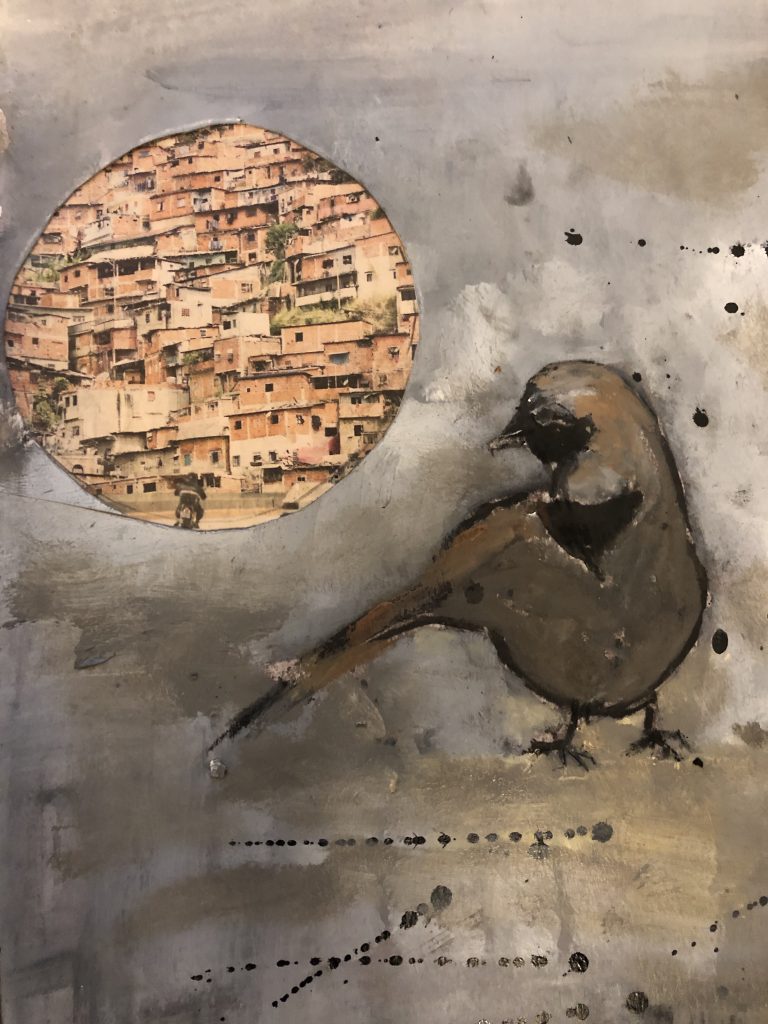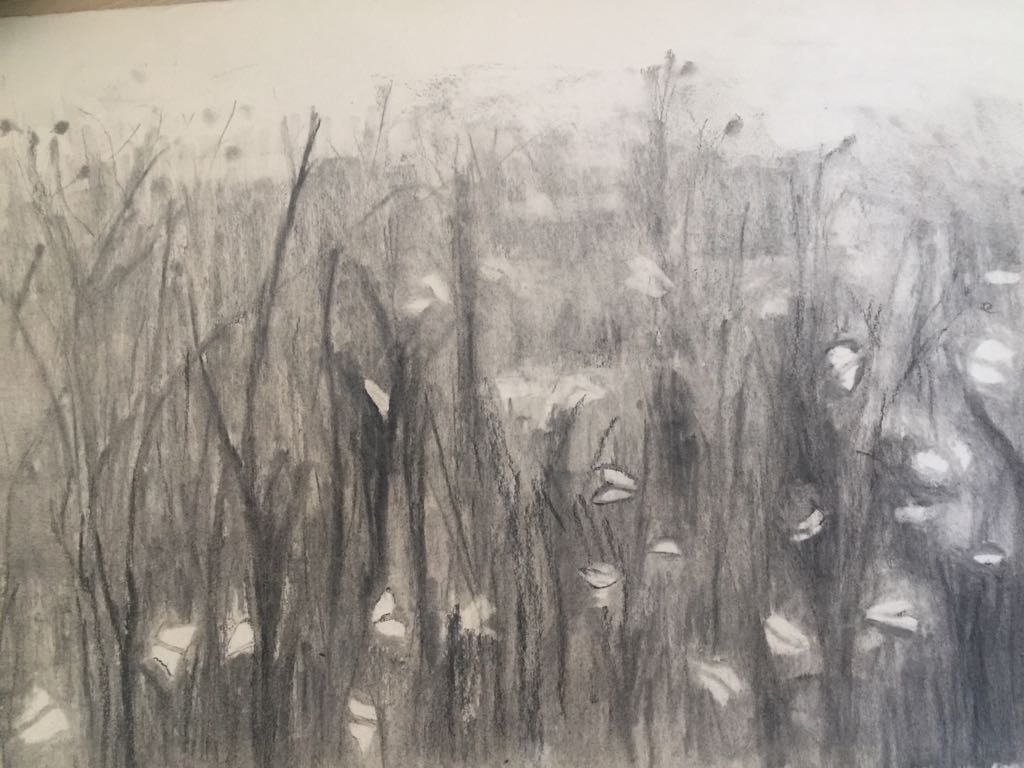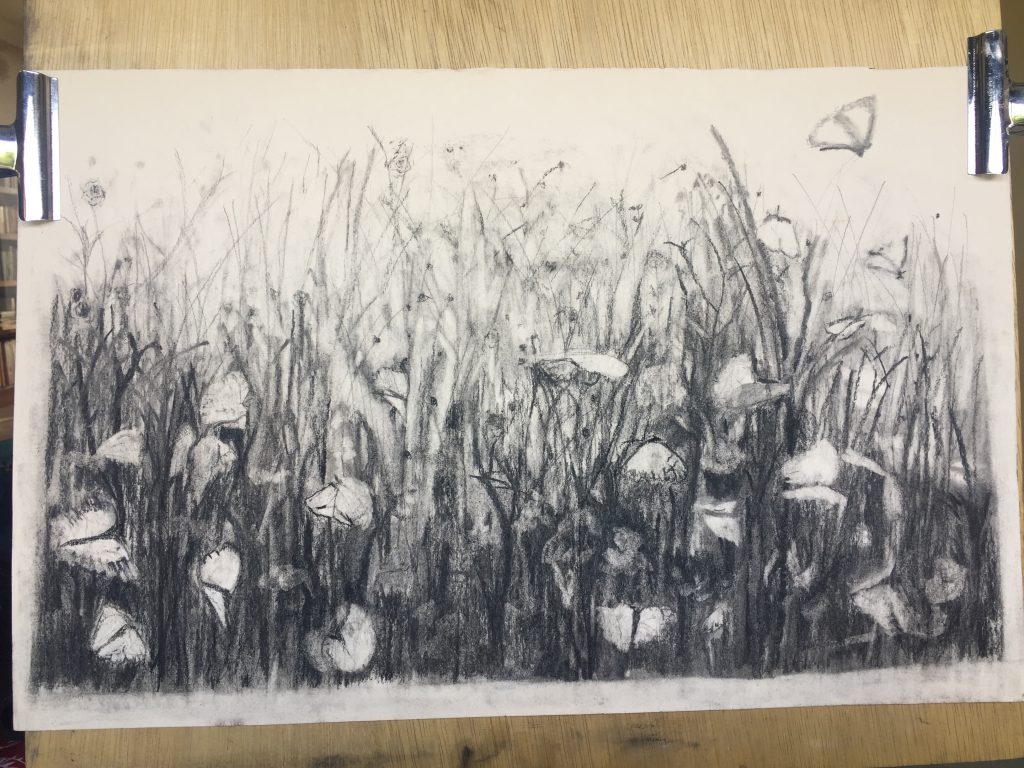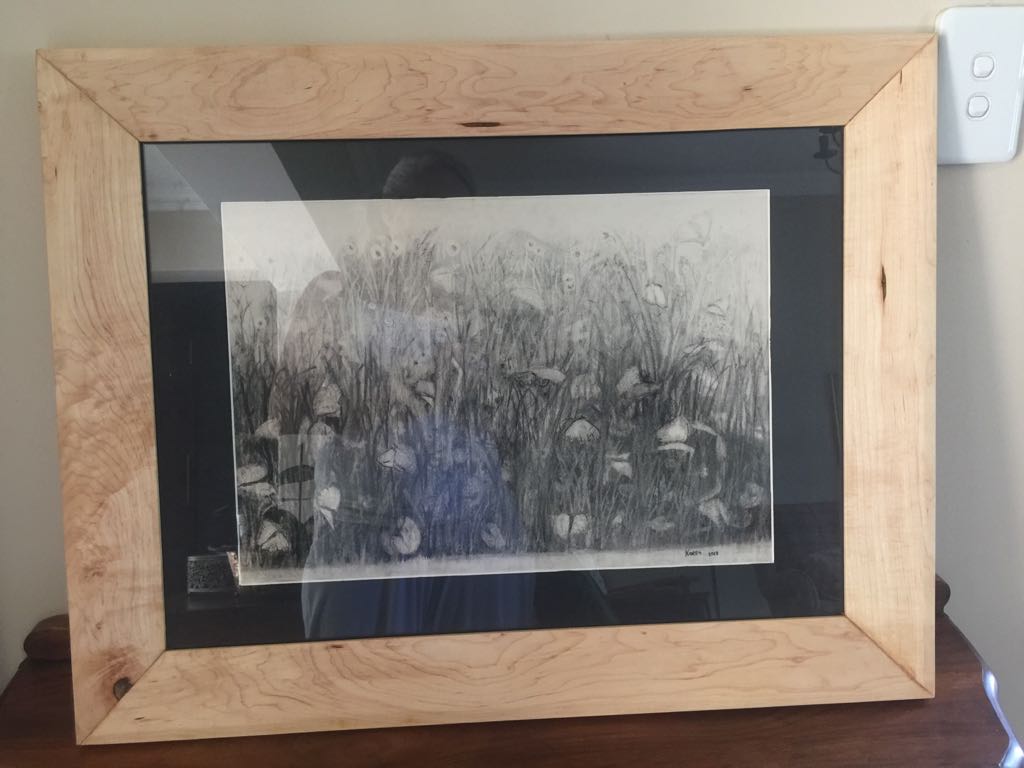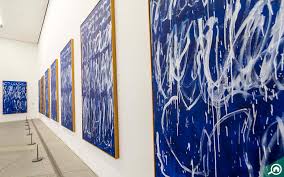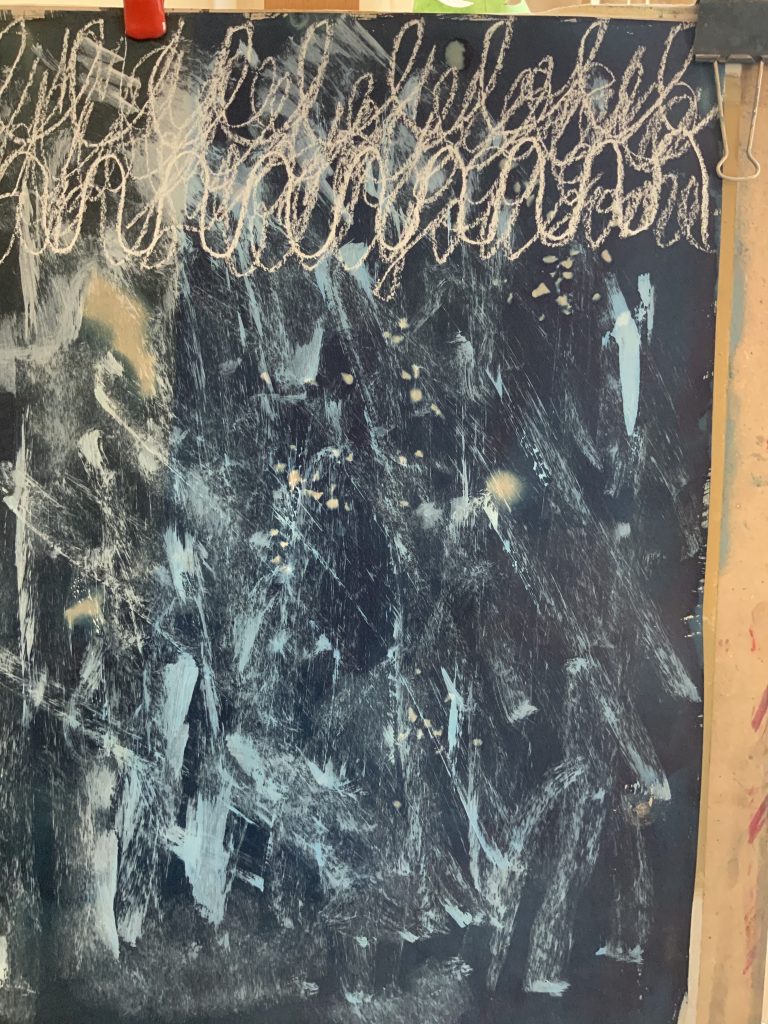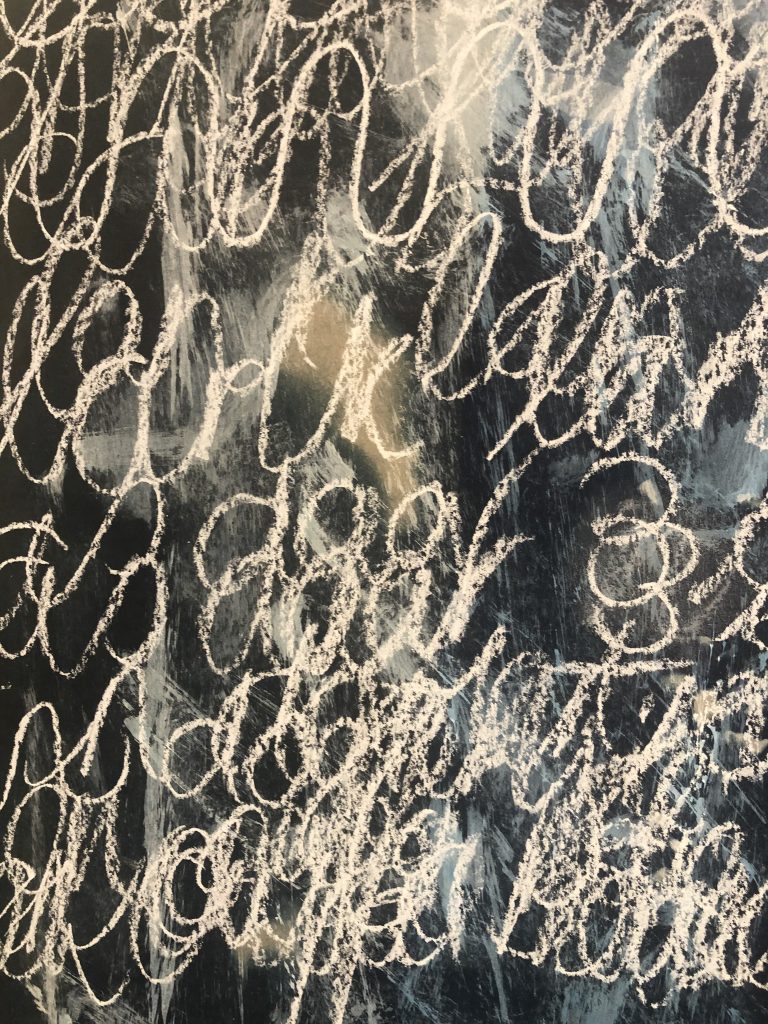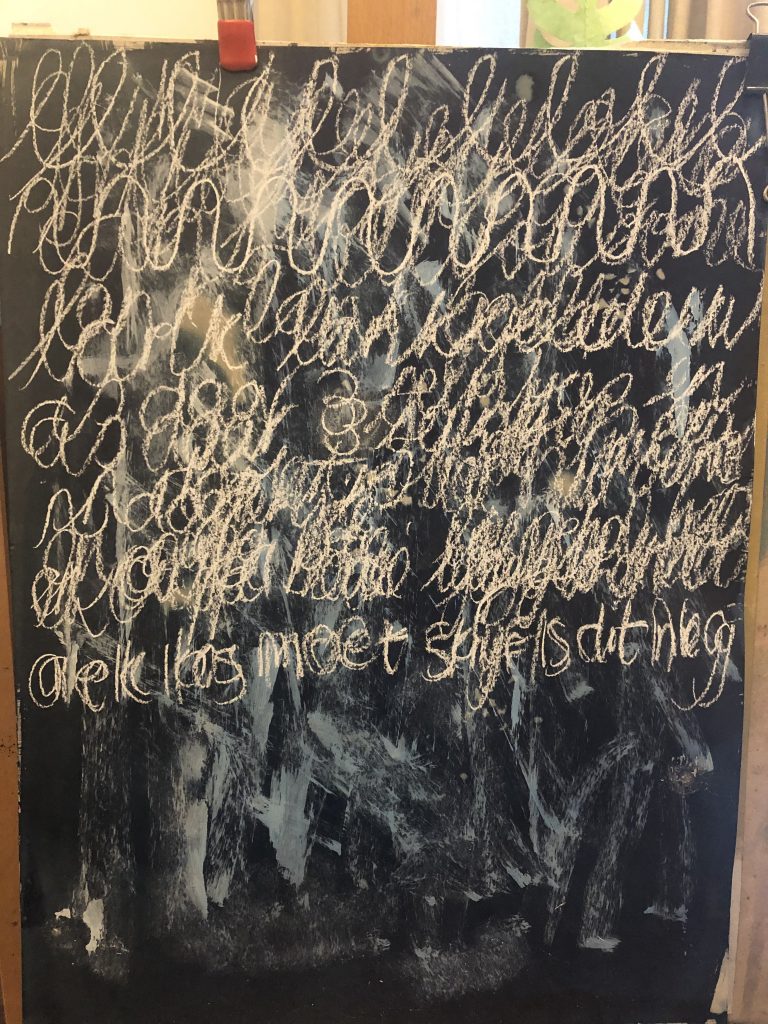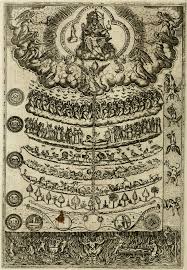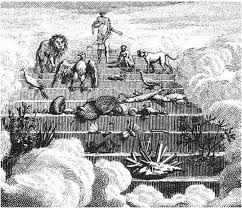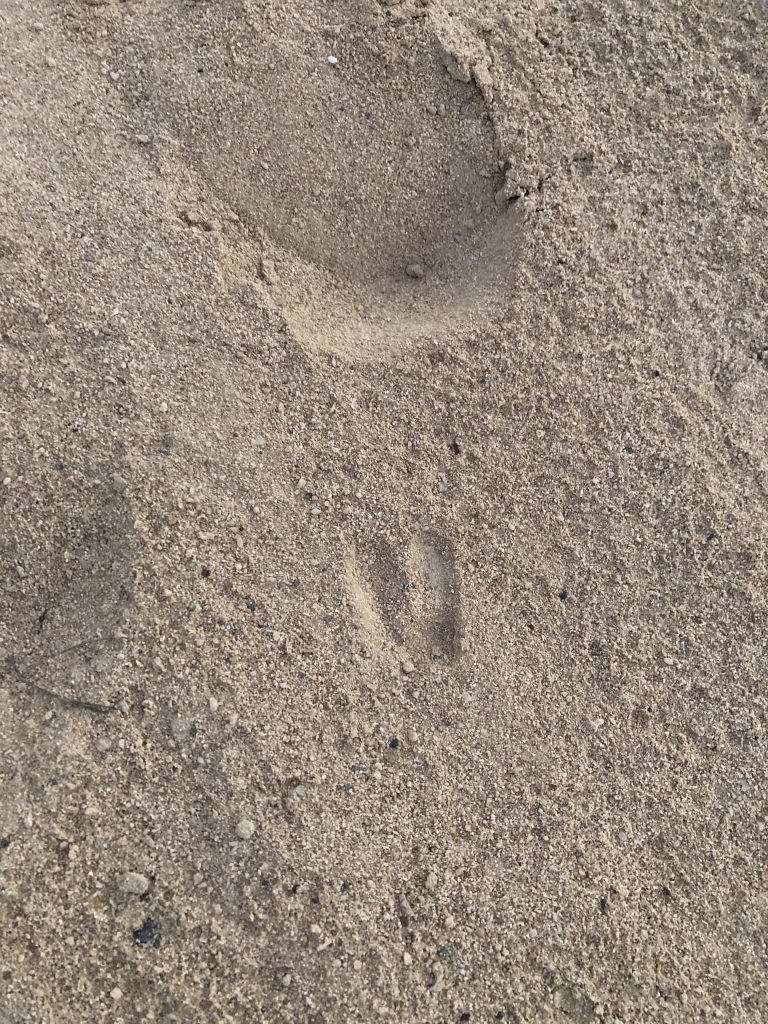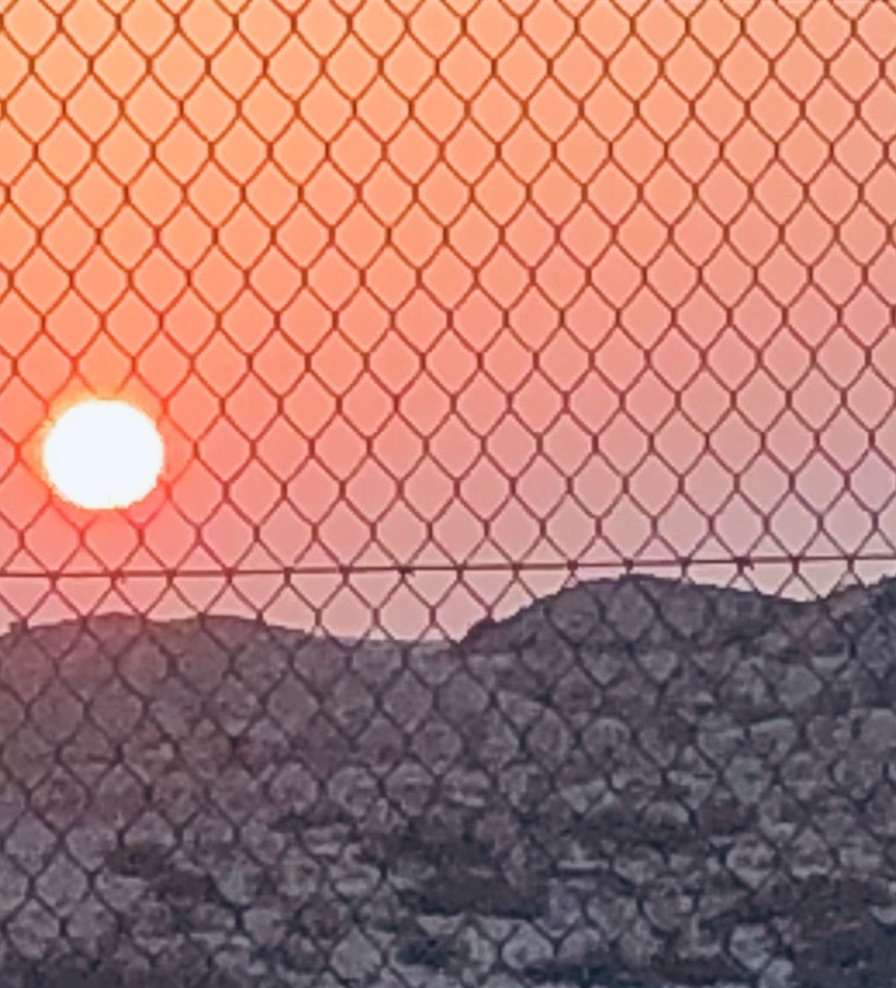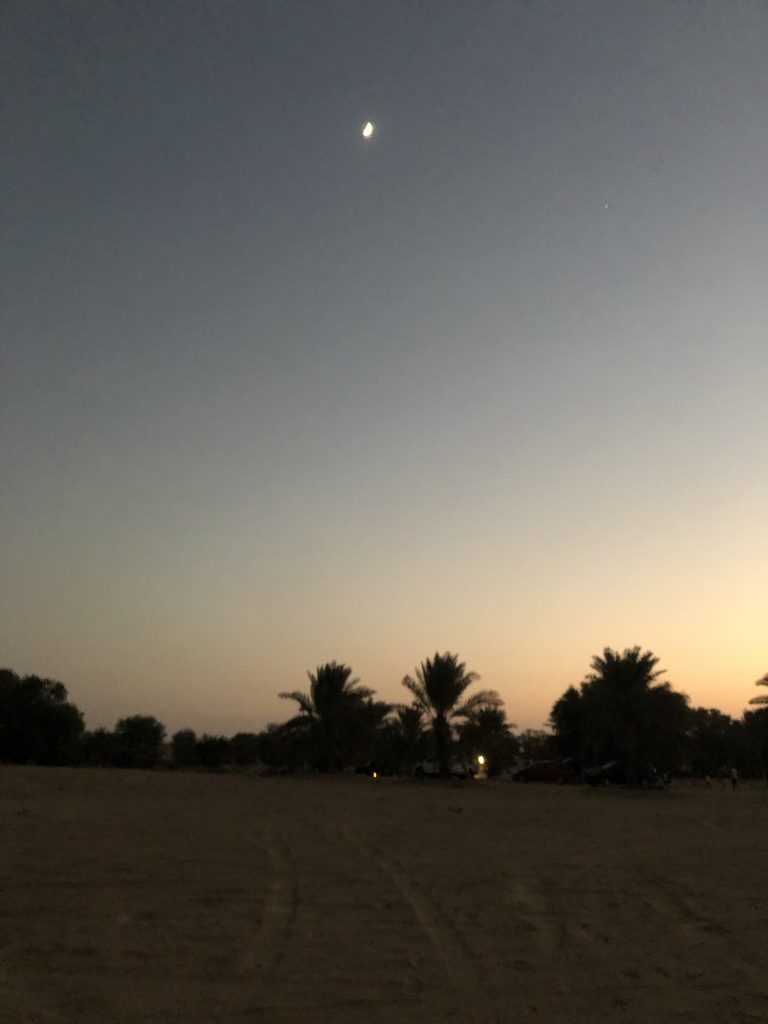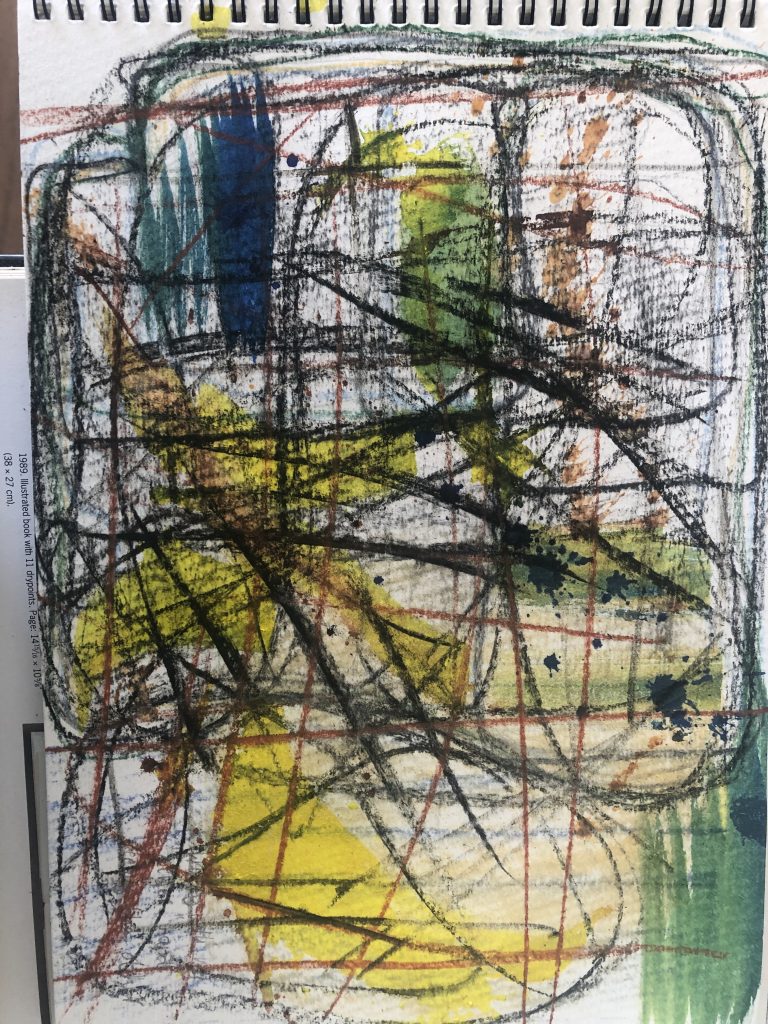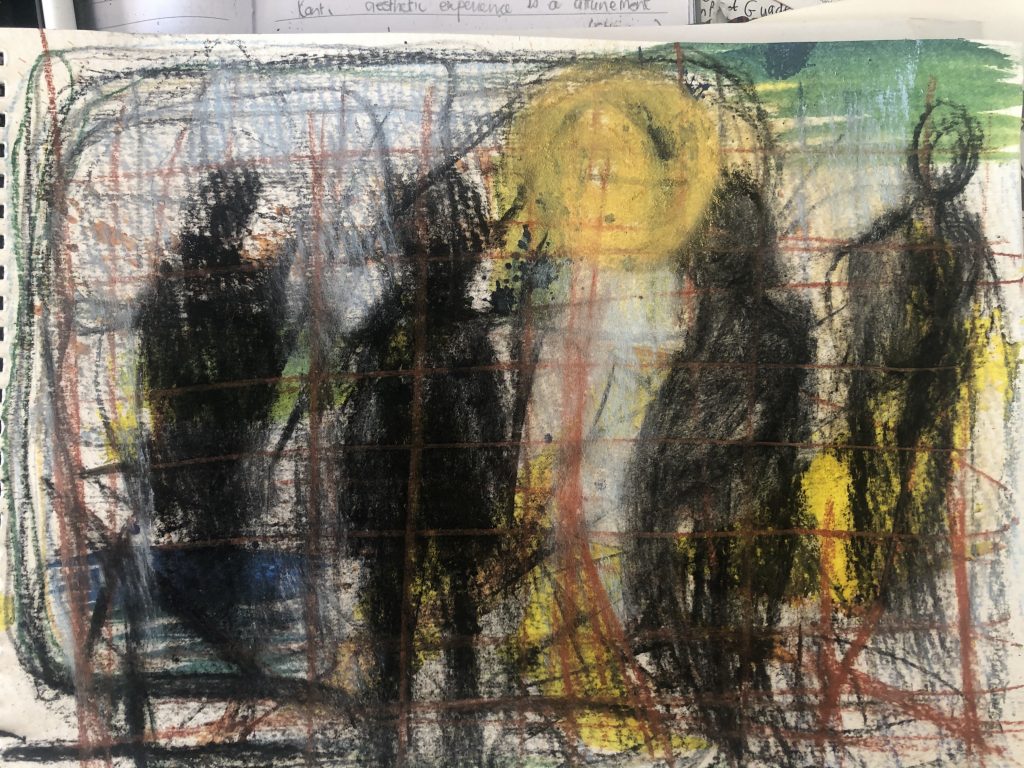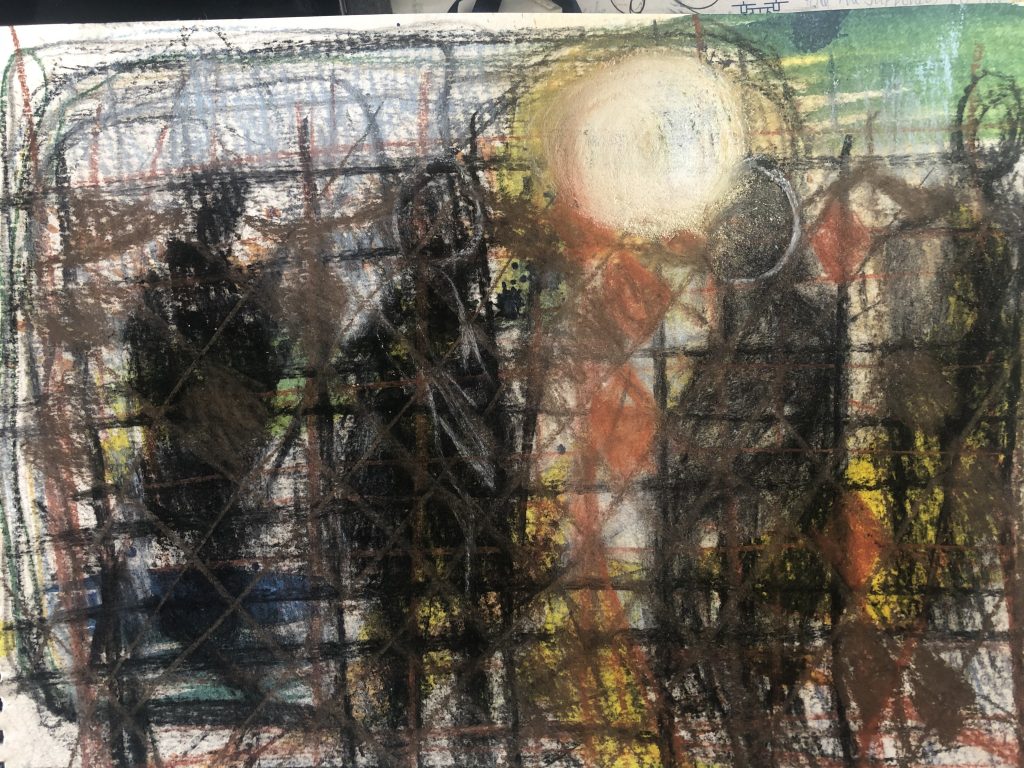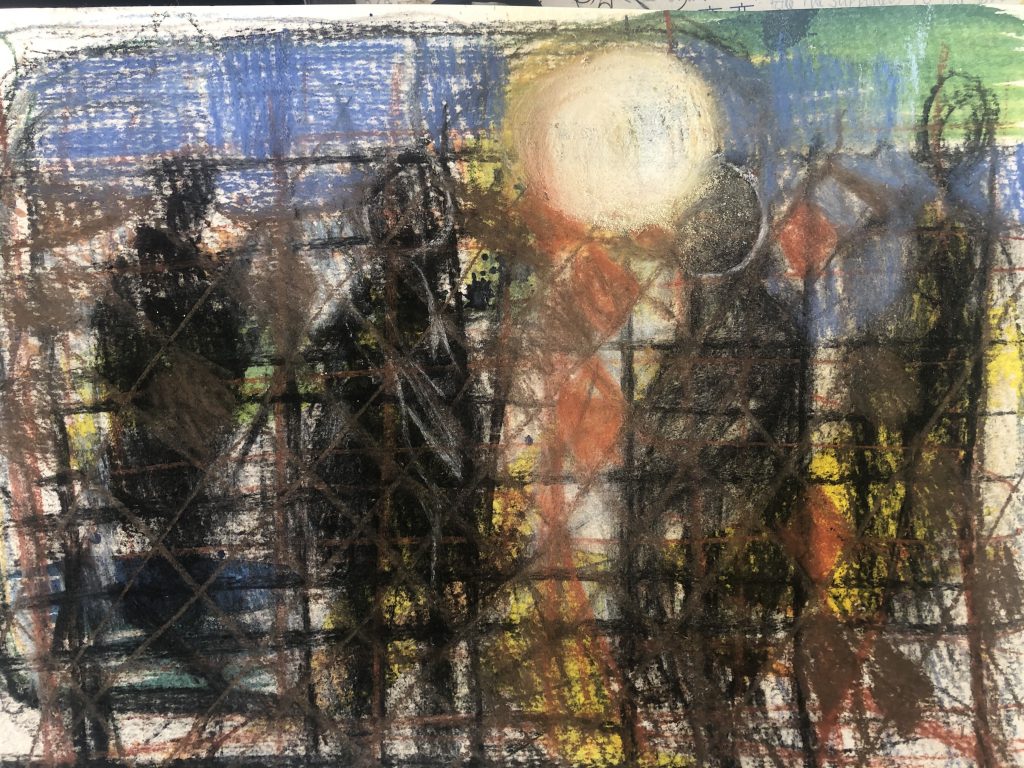Topic 1: Experience and authenticity
Identity
In the study material on Identity I read the following: “The debates at the time around authenticity, appropriation and authority that Love raises in her essay ‘The Experience of Art as a Living through of language’ are equally relevant today.” I looked at the artwork shown in the study material – how we identify our own identity is a very complex issue as well as a difficult/vulnerable place to go to as an artist. I do think the viewer needs to be able to relate to a work to understand what the artist work is about. I remember self portraits I have done in a period when I was going through emotional turmoil and how painting helped me to give a voice ( constructing something about myself) layer by layer. This eventually was the reason why I decided to study art. I felt it answered my need for expression and gave me a deeper sense of purpose, something which I could almost own up to, private, and yet also connect with my world. The studies would give me more context and sense of how making art can become a bigger part of my being.
In the Communicating Arts Online Magazine, Wendy Richmond writes: “The definition of cultural identity is how one perceives oneself in terms of belonging to a group, whether that group is based on nationality, ethnicity, sexuality, religion, lifestyle and so on. As an artist, I’m especially lucky when I’m exposed to—and can participate in—the wealth of cultures outside of my own. These interactions bring depth to my work; they make me a better communicator.” (Richmond, 2019) She then goes on to talk about visiting Tijuana in Mexico and wanting to bring some of what she saw into her own work, but was concerned with cultural appropriation – she then talked to a friend. “…When I was writing that column, I sought the advice of a wise friend, and he gave me an alternative perspective. “You do have a cultural identity,” he said, “and it is an amalgamation of cultures. Culture is like chocolate at 98 degrees. It’s sticky, and you can’t help getting it on you.”
Richmond, Wendy, (2019) ‘Culture is Sticky’ In: Communication Art Magazine 2019. At: https://www.commarts.com/columns/culture-is-sticky (Accessed 21 September 2020
Exercise 3 Theory and practice
Thinking about Reading Point 1: Kate Love’s assertion that there exists a theory/practice binary operating in art schools, does theory relate to your studio practice in terms of influencing your ideas, processes or the way that you reflect on/develop the work you have made? Write a paragraph in your learning log describing your experience so far.
As human beings we have a need to connect and communicate our thoughts and experiences to what happens around and inside us – art making is my visual form of this expressive need. Am I asked to examine the idea of theory vs. practice as a point of departure for learning? I feel strong about and idea of theory and practice as harmonious points of departure for learning, that I why I choose to study for a degree in Fine Arts. Theory explains the processes (have facts attached) art use to represent, understand and communicate and in my practice I see searching, researching, questioning, connected to my visual thinking in the way I use/ learn to use charcoal, pastels, paint or other mediums.
Theory suggests (the subjects I have studied) a deeper looking and questioning of my methods and ideas, about how I observe, how I find layers below the obvious, finding form, line, shapes. Theory also asks me to reflect on this process in words and try to explain and question/critique my choices during this process. I have learnt that this process of making is unsure and fragile, it is mostly about solving problems, questioning and freedom of experimenting; and includes risk taking, which can lead to failure. It also becomes a process of documenting, a form of archiving a process, which can be seen as more truthful of the experience and work making process. Through repetition and staying engaged my practice my art making is sustained and developing. I also like to think that I am learning to use visual thinking more integrated with words. But then, one should be sure theory leads to critical response – stays open to any conditions of possibility and not become ‘doxa‘ – hold on to its ‘agency’? I have felt at times during my courses that theory pushes me into certain directions, which asks a certain personal openness of self in relation to a practice, but by writing about it, it gave me the opportunity to be honest about the experience and question it.

Above drawings is about landscape lines I made on the farm and thinking how I could show these wheat fields. It was at that time also mainly about time on the farm, how things change as the work on the farm from sowing to harvest change the physical landscape.
Picasso was quoted as saying, “I have a horror of people who speak about the beautiful. What is the beautiful? One must speak of problems in painting! Paintings are but research and experiment. I never do a painting as a work of art. All of them are researches.”
Vogue Magazine (Nov. 1, 1956)
Authority of experience
‘….in that this reading of experience as authenticity implies that ipso facto the marginal subject’s experience of otherness is so authentically unknowable – so elsewhere – that it couldn’t possibly make sense to the rest of “us”.
Love, 2005:161
Love considers the idea that we do not have to bring words to art, “but rather that we can use the experience of art as a form of criticism itself” (Love, 2005:157). She feels these experiences are far more useful in its relationship to art and the politics of subjectivity. It seems Love is critiquing the use of personal experience rather than “that experience as it might be understood discursively – inter-subjectively – or as very deliberately, an experience ‘of’ a social or critical or contemporaneous issue.” (Love, 2005: ) Her concern is that: “Unfortunately, this sort of round about thinking engendered a morbid re-visiting of a previously much discredited belief- that is, that the representation of experience would guarantee transparent access to an authentic knowledge of subjectivity. As a consequence, the insidious acceptance of this idea, in many diverse contexts, similarly led back to the older, and relatively pernicious, understanding of the subject as a singular, autonomous and expressive individual.experiment with ideas and in my work process to not focus on the outcome, but to view the work as part of a body of work, that could change over time, in terms of meaning and presentation.” beliefs served to legitimate reference to experience, in art, as entirely ‘one’s own’ -that is, as if knowledges gained through experience were able to deliver meanings which were immediately present to consciousness.
Does everyone have the same right to tell a story and to respond to it?
Think critically about above…..as questions such as what do I see/notice? and what is happening here, how does is make me feel? Use time to reflect upon. I believe it is hard to share experiences and words can make it even harder. Difficult narratives/subject in art can be a place where the viewer grows to become more emphatical, being removed from your own direct experience and culture, and have/experience compassion, ridden of biases. I think shared experiences make us less self centered and creates the ‘us’ of connectivity and interconnectivity, but I realise one should also be wary of power of words and how people can use it to control and manipulate. I do think, as paradoxical as it might sound, that just as no one can completely understand another person’s experience, one can try to understand (reach out to that which is unknown to self) how it feels to have a particular experience, before you interpret it as that persons’ truth.
The words of sculptor Phyllida Barlow (in previous part of the learning) comes to me: ‘...why should art be understood? That overused word ‘experience’ is a catchall, and too limp and pathetic…... ” (OCA study guide:70) I started reading a book on Wunderkammer, and an article with Silke Dettmers discussing Barlow’s comments. I sensed the push pull of dualities of our modern systematic thinking, which most probably lack feelings of ‘authentic’ and spectator looking for the magic/spectacle because it is insatiable by nature according to Dettmers. She suggest wonder is not wonder if it ‘fails to startle and disrupt expectation’ and must be coupled with curiosity. Here we have an exterior wonder which could be connected to addictions, versus an ‘inner appetite for something unnameable that has no closure’ (SD) Dettmers says that theory rarely acknowledges ‘the very different processes that art is subject to” and she refers to Barlow as being ‘vehement about art writing’, that in using words, in the interest of art, it becomes a trade-in for a direct experience with a work of art. It seems for Barlow there is value in a ‘material experience – she writes: ‘what if touched?. Cold, damp, warm, scratchy….”
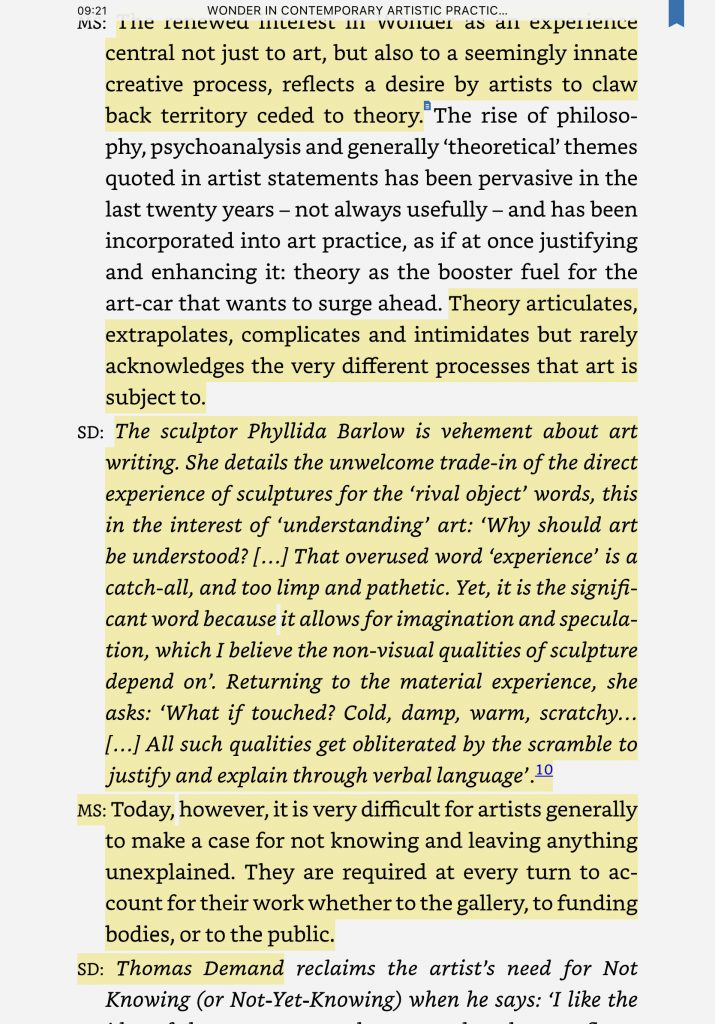
Love asks the same question when she summarize (Love, 2005: 163) “(1) there is an enduring belief in the transparency of lived experience; (2) ther is no interface or “transmission noise” between experience as the ‘buzzing confusion of things’ and its interpretation…” She concludes”..so to be able to say that we have sufficient authority to guarantee the truth of an experience means that we must believe that there is no interface between experience and language.” She reminds us of the traditional meaning of experience.
Reference list
Barlow Phyllida, At Sea: a conversation by fax between Phyllida Barlow and Alison Wilding 22/08/98 – 02/09/98. OCA study material (p70) and Wonder in Contemporary Artistic Practice Kindle version
Dettmers, Silke and Sanderson, Mark, The Enemies of Wonder, An itinerant conversation. in Mieves, Christian and Brown,Irene (eds) Wonder in Contemporary Artistic Practice Routledge Taylor & Francis Group New York first edition, published in 2017 , New York, Kindle Version read on my Ipad. pp 241 -244
Love,Kate 2005. “The Experience Of Art As A Living Through Of Language.” in After art criticism: New responses to Art and Performance. (2005) pp 156-175. Print.downloaded from OCA library https://ebookcentral.proquest.com/lib/ucreative-ebooks/reader.action?docID=350918&ppg=149
Are some voices more or less valid and for whom?
One should ask to which voices will people listen, respond to….take serious?Do they want to hear/deal (with) these difficult narratives? Recently I read something former US president Bill Clinton said, “When people feel uncertain, they’d rather have someone strong and wrong than weak and right,” Clinton said. (WashingtonPost, 4 December 2004) It makes me think about how we function in uncertainty, which to me is the reality of life. It also opened me up to voices that are different in their views – challenge my ideas, or even disregard it.
It made me think about choices people make when unsure, fearful and insecure and what art can do about it – how it reacts.
The mediation of experience
Exercise 3.1 Authenticity and audience
Research online the 2017 exhibition ‘The Chapel’ by Kenyan born British artist Michael Armitage at the South London gallery and listen to the interview with Sandhini Poddar. Consider Armitage’s background, education, career as an artist and reflect on the issues around authenticity and appropriation that you have been examining. Do you see any contradictions or problems that his painting might raise? Based on your online research, write your own review of the exhibition, in relation to this in your learning log.
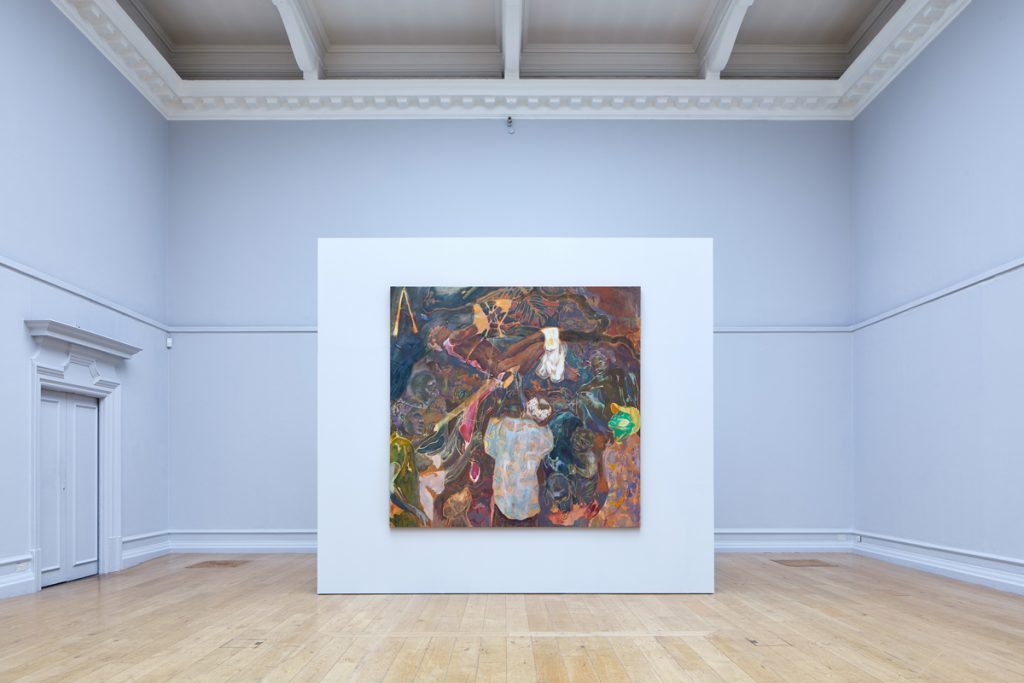
I started to listen to the interview between the artists and me S Poddar, and became somewhat irritated with her long question (which became interpretations of the body of work) It is as if she was trying to put all of his practice into her own understanding and associations and also locating him as an African artist, whilst also trying to deal with some form of otherness a to and fro between being African and a British born/culture . Why is it important? Is he different than who? I am reminded of research on experience and understanding in language. That aside, I expected more ‘room’ for the artist to share how he use his ideas and get to meaning in a less directive discussion. Writing this I realise I am going a bit off the intended direction, but I feel here is a layer of curator/art historian trying to find/indicate/direct “hidden”/other meanings – nudging the artist to ‘reveal’ to the audience. Is it a form of manipulation that irritates me? The artist was very eloquent to describe his preparation of the body of work for the space it was intended. Video footage of the work is shown during the interview and one do get an idea of the layout of the exhibition space, one room. Below is short notes I made of the conversation in order to understand the exhibition, which I have not been able to visit and will attempt to review:
- For his solo exhibition, The Chapel, he, after being asked to do the show, decided to visit the space and get a feel of it.
- He used his feelings of relating the proportions and quietness of the space (the South London gallery) to a chapel, to create his body of work, which also consisted of large-scaled paintings. I have my own memories of visiting museums and comparing the feeling with that of being in a big cathedral – being quiet, sheer size and atmosphere of almost being cut off from life outside.
- He focussed on the function of a public art space, located within a community, for the community, compared to that of a chapel as being integral in a (multi faith) society which can be used as a place for contemplation and conversation – he talks about how that ‘echos’ aspects of a chapel.
- It made him think if art can also talk to these different aspects – can these be evoked or considered in his work?
- He was thinking how people relate to the Christianity in Kenya and how he could use religious motives that would relate to know Christian imagery.
- Often subjects that he approach are about violence in East Africa and are violence against the body – thought about Western Culture and looked at moments of possession (demonic/devil) he has seen, heard or read about .
- Goya features in his work – use of caricature to tell a difficult story.
- Looked at exorcism – the narrative is mostly women who are possessed.
- He wanted the surface of the work to locate the subject matter, the language, the place – there is a certain mystery attached to this cloth.
- The Lebugo bark cloth comes from Uganda, where” the town of Masaka is the center of bark cloth production. For generations, Baganda witches and spiritual mediums have used the cloth in association with the afterlife. The Baganda make this venerated fabric by pounding the inner bark of the mutuba tree (Ficus natalensis). This laborious process produces a stunning cognac-brown material held in such high spiritual regard that seven sheets of it are wrapped around a deceased Baganda’s body before burial. It is believed that this material alone has the power to transport the soul to the land of the Baganda’s ancestors.
- This surface is full of irregularities and resits the paint surface in many ways, which forced Armitage to change his painting style – his paintings became thinner and much more layered.
- The Chapel was accompanied by a publication of essays by Mukami Kuria and Roger Malbert.
- Michael Armitage was born in Nairobi, Kenya, in 1984. His parents is a mixed race couple, his mom was born in Kenya and from the Kikuyu tribe. He was schooled in Kenya as well as the UK
Thinking about writing a review of the exhibition.
I have seen his work at the Venice Biennale in 2019 – I could experience the tactile bark cloth he works on and how he uses the materiality of cloth with his painting style , the size of his works as well as see his use of narrative of story telling about life in East Africa in that particular body of work. He has taken a few years to develop his technique to paint on the bark surface. The fabric takes more contemporary forms in recent times – there is an Ugandan-born British designer José Hendo uses bark cloth as inspiration for some of his sustainable runway looks. (National Geographic, ) I have to find images of the exhibition and the space and will show them below. This was his first major solo show in a public gallery in London. On the website of the gallery I read that the exhibition consisted of a series of 8 large-scale paintings. It seems the Flaying of Marsyas can be seen as the centrepiece of this exhibition – a man being skinned alive, whilst hanging in a tree and based on Greek mythology. The work references Titian’s sixteenth century composition of the western narrative. The titles of the work are as follow and a pdf document is attached to read about these works:
- 1. Hope
- 2. Conjestina
- 3. Nyayo
- 4. Flaying of Marsyas
- 5. Lacuna
- 6. Exorcism
- 7. Seraph
- 8. Anthill
In a conversation with Brooklyn Rail’s Toby Kamps, which also includes a question/answer session with members of public, I found the ideas on exoticism compelling to his work and want to discuss the reference to distinct African origin and exoticism and how the viewer and culture define such a cliche – in the interview the artist contemplates that it creates an “emotional distance, a hierarchy, that leaves the exoticised subject as being primitive, under developed, corrupt”, and never bringing it into the space where it is seen as complicated and interesting, as if the viewer and his/her culture is the other. I read that Gauguin was an ‘unavoidable’ touchstone in his exploration of the exoticising gaze, and he wants to understand the phenomenon as it occurs from outside of but also within a society. ‘What happens when you as a culture, or your people start to self-exoticise? What does that mean for your culture and for the practices that you have?’ He very much sees this as a slippery position, being a Kenyan Brit and growing up within Kikuyu culture as well as British culture – but then his work is about these questions, trying to figure it out. He asks, did Gaugin see himself as exotic, as opposed to looking at it the other way around. Myself being a South African, people have questioned my ‘whiteness’ – who am I then? It is something I do need to explore, as my country has a horrific history of Apartheid and after more than 20 years of being a democracy, racism and colonialism are still positions of major concern when it comes to identity, cultural similarities and differences. When Andy Warholl made his famous paintings of Marilyn Monroe he pointed to something about identity which I find understood recently after doing a short course about art and identity, what I learnt he was pointing to is that it is not what you are that counts, but you the world wants you to be. To add to that, I heard Catherine Wright on a Ted Talk giving this great advice at the end of her talk on Art and Identity: “….. because otherwise we simply will have to become what we think other people want us to be” We need to know ourselves, how ever painful that is.
In the Apollo magazine, an online article also discuss this and I do like their concluding remarks: “His paintings may be beguiling, but Armitage’s eye is cool and unsparing, keenly aware of the threat of a self-exoticising viewpoint. He invokes the titans of western painting from Gauguin to Goya to Picasso, but his works neither insist nor depend on the comparison.
‘I’ve never had the weight of feeling like western art history is my own,’ he muses. ‘I always feel like I’m looking in.” Apollo:June 2017
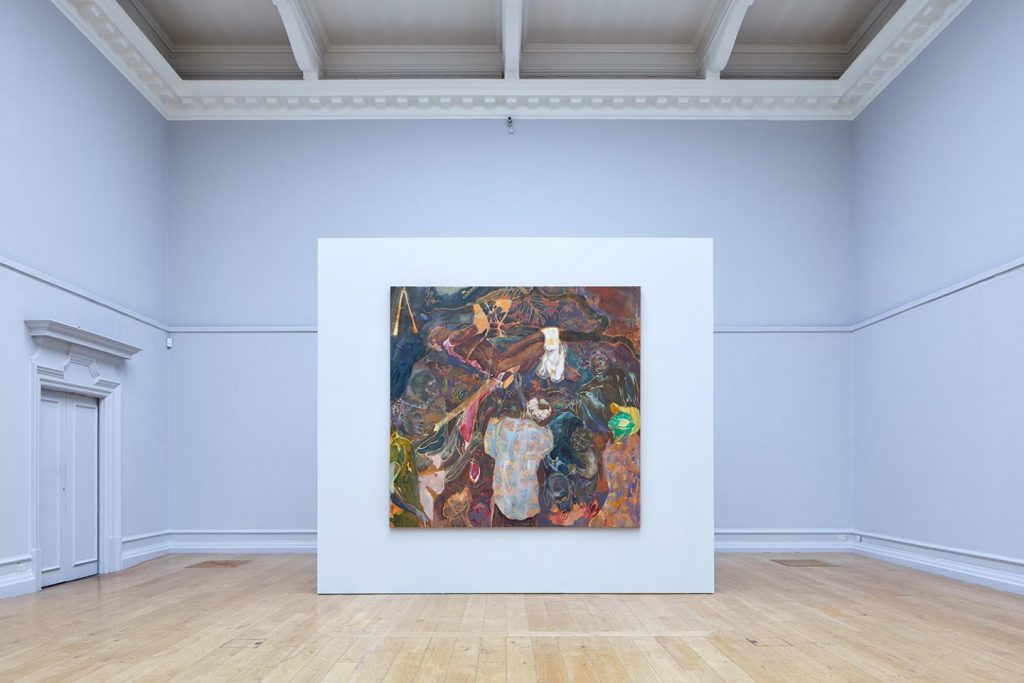

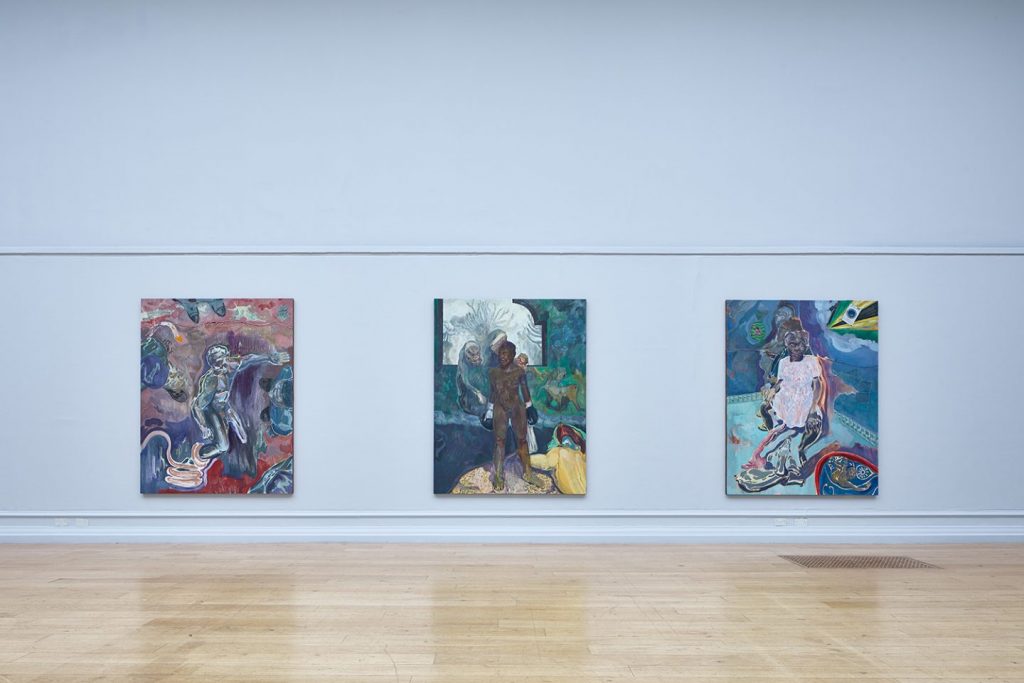
Review of The Chapel at South London Gallery during December – February 2018
Michael Armitage was born in Nairobi in 1984 and studied art in London, he completed a BA at Slade School of Art in 2007, and his MA at Royal Academy, London 2010. He works and lives between London and Nairobi. His paintings represent multiple narratives which he draws from historical and current news media, internet stories and his ongoing recollection of his home country. For his first major solo exhibition in London he presented 8 large scaled oil paintings, which is exhibited sensibly to utilize the space of the gallery to resemble a chapel. He considered how Christianity in Kenya has shaped different attitudes and plays with the imagery, narratives, own experience of seeing and hearing these concerns with one of the works he presents in this exhibition. The Flying of Marsyas pose as an altar piece. This work references Titian’s sixteenth century composition of the western narrative. Below images shows the two works to compare.
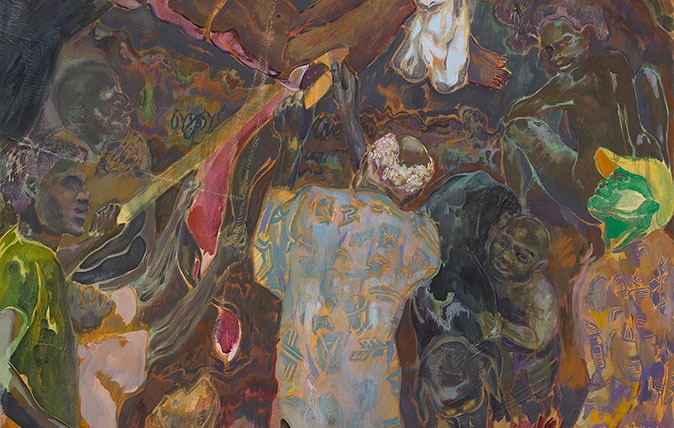
The Flaying of Marsyas by Michael Armitage, 2017 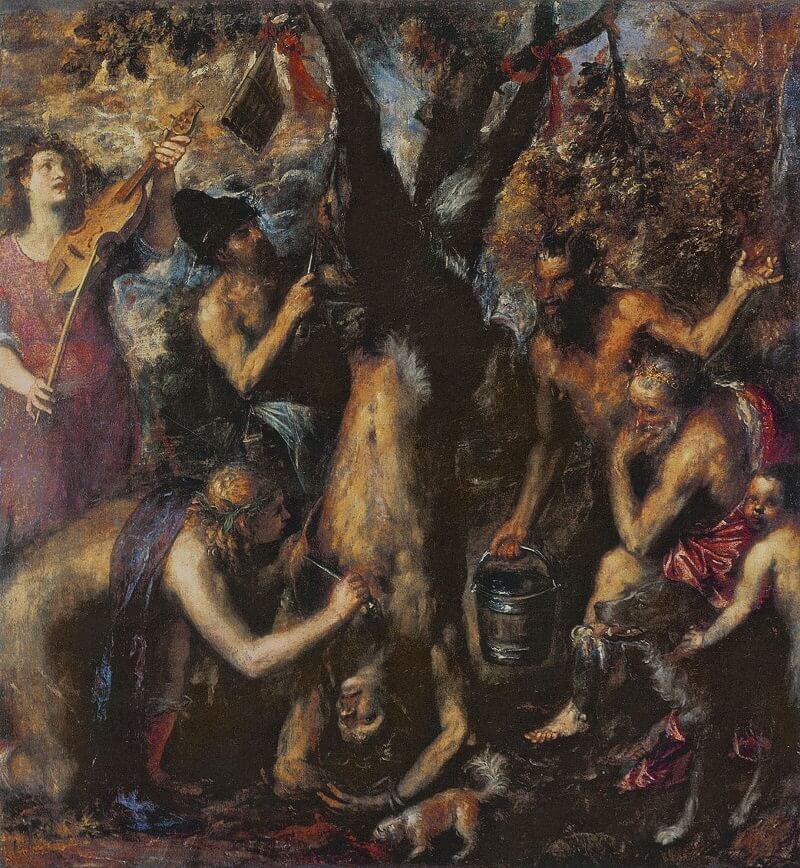
The Flaying of Marsyas by Titian, 1575
When looking at The Flying of Marsyas, one sees that he inserts imagery of an ‘African violence’ into the European narrative, and thereby points the finger back at the western world. Lilias Wiggin (Country Life, 2018) describes it well : “This is a universal violence, for which the responsibility is global. Mankind is inexhaustibly capable of inflicting unjust pain.” The mysterious central figure of the flayer, who offers his back to the viewer is intriguing as he gives the viewer not a lot of information, although the artist explained that it came from a character in his own documentary of the bark-skinning process. One could ask oneself if the artist is offering a counter-discourse on this narrative, by engaging with it. In a way he is showing that in art a same story can be told differently. He has a firm belief that art is an agent of social change and uses his captivating figurative style to compel the viewer to take a deeper look at the content body of work addresses. Is he questioning passivity of watching news media: implying the viewer?
The paintings have dreamlike scenes of anthropomorphic animals and fable-like unresolved narratives by which he address current concerns in East Africa, such as abuses of power by politicians, superstition, and post-colonial social injustice. He weaves these multiple narratives, which is drawn from the media and Kenya’s mythologies, to form his own contemporary scene. This approach in his work allows him to raise the discussion of the impact of oppressive narratives from the perspective of either region.
‘Lacuna’ is built up with gradual layers of thin washes and sketched outlines, others are gestural and in his work colours reminds of the Fauvist painters. Goya is one of the most important painters for him; he relates to Goyas subjects and how and why as that became fundamental to his own approach. Cézanne is important in terms of colour and mark, and Seurat for understanding the way colours work together. During 2014 he started to paint on Lubugo cloth – this is handmade from bark from trees harvested in Uganda. The cloth is used for burial purposes in Uganda and became a tourist attraction to buy as a souvenir by the time he discovered it in the local markets. This means it became removes of all the significance for the local people, and his use is to have an element in his work that referred to this significant change of culture that’s happening as Kenya and East Africa develop. That does not mean that one should ignore the ideas of embodiment and myth that this material has in the African culture. The material also forced the artist to incorporate the surface into his work. In most of the works we see forces of life and death at play as me S Poddar was referring to in her conversation with the artist during the opening night and the artists use of the bark cloth as canvas.
Reading List
Allsop, Laura, June 2017, The disturbing dreams of Michael Armitage, Apollo International Art Magazine, June 2017, accessed online on 28 September 2020.
A studio visit with Michael Armitage. He talks about his concepts and the bark cloth he uses as canvas. He said “the paintings develop quite slowly, usually.” 2017. | Video by Turner Contemporary
Michael Armitage discusses his exhibition The Chapel at South London Gallery with art historian and curator Sandhini Poddar. Armitage talks about themes of the work including how religion and Christianity has shaped daily life in Kenya, the relationship between man and nature and the symbolic use of Lubugo cloth for ground of his paintings. The Chapel 13 December 2017–23 February 2018 South London Gallery, London Duration: 8:48
Exercise 3.2 Universal versus specific
In fact, Love goes further and proposes that an experience does not happen to you and then you put it into words, but that it is always already in language. This would mean that you are already formulating what you think and feel in the moment that something is happening to you. Love proposes that the reason Agamben believes that the authority of experience is lost in modern life, is because he is:‘…anticipating an authority which would constitute your experience as neutral, disinterested, impartial – a relation to the world which could make your trajectory through life feel more real, elevated, enduring, strong, certain…this is what he feels has been lost.’
Love, 2005:163
In contrast to this disinterested, disembodied, neutral subject that Greenberg insisted on, Love continues the poststructuralist project and posits that such a universal authority cannot exist and therefore to try to guarantee the truth or certainty of experience is contradictory. The conventional understanding of experience, therefore, needs to be reconsidered.
Do you think that experience can be universal, that underneath the differences of gender, class, ethnicity we are all the same? Or, is the ‘universal’ only ever able to represent the values of those that have power? Discuss this with another student and record the conversation in your learning log. You can connect with other students through the OCA forums, or through using the map of student locations on the OCA website to make contact with a student in your region. You can also discuss with a friend, family member or colleague.

Agamben looked at life and considered the force of ‘potentiality’ (JSTR article) of language, the fact that it exists, its materiality was considered, that is prior to the meaning it produces. He talks about people becoming aware/conscious of language – the mere fact that we speak and that relates, or could be seen as the same as how we relate to our own existence as possibility or potentiality – this is universal. It seems Love explores the same notion by investigating writing about experience as a practice of fine art, just like painting. It seems she is trying to understand experience as content and as interpreter. She is aware of the need for authority to translate this into words and language, which she calls ‘the power of words and narration.(2005 p159) It seems to her when experience is compared with other modes of consciousness, like understanding, knowing, recognizing it is mostly aligned with actuality and thus viewed as authentic. I think this is also what Agamben saw as the hyper reality crisis. She reminds us of the authority that Agamben expected and how it differs – traditionally it was about “a sensate, experimental, essential emotive undergoing of the world (2005 p163) She discuss this with an example of reading an article about the art critique Adrian Searle, on the work of T Emin (The Guardian, 12 November 2002) This took my down another rabbit hole of experience and identity, which I would like to share here, as Love send me in this direction.
I read a few critics comments in the Guardian on Tracy Emin and it is clear that her work is experienced as confrontational and then go back to page 163 where Love contemplates the dilemmas of experience where Searle sees the work as too empirical, too personal, too self interested – lacks the authority presumed for intellectual language of high art? Searle sees her only invention , and only subject, as Emin herself. So this is not art…..his knowledge of art made him think that? Love writes that she must do the following: “ I must write this down, will I remember it, o the tyranny of these little pieces of paper……Am I frightened that it’s a strand of me which “I” will never see again?” The artist feeling she must record it, as if experience were going to slip away from knowledge. I see Emins work strongly related with writing and constructed with a narrative of her own truths rewrited by herself. I do think many viewers think they know all, is privy to that information and see her life of art as a form of reality show. Roberta Smith critic of The New Yorker says the following about Tracey’s work: “In her art she tells all, all the truths, both awful and wonderful, but mostly awful, about her life. Physical and psychic pain in the form of rejection, incest, rape, abortion and sex with strangers figure in this tale, as do love, passion and joy.”
In an article published by researchgate.net, the author writes the following: “The artist insists that her use of her own biography is more about a desire to share than it is about narcissism. The purpose of her work, Emin admits, is to show others what she has experienced and it is this confrontation that can be both ‘uncomfortable and exhilarating’ for the spectator. By forcing viewers to face her traumas and sexual escapades, Emin places them into the position of voyeur, confidante or witness – positions that some critics do
not like to occupy.”
Love sees the function of experience in a work is to take us to the limits of our knowledge and then act as a form of criticism on the world it inhabits (2005,169). The viewers response and the artists attitude is often where the value in art is found (2005,172). She makes a comparison between how different the work of Emin and photographic artist, Richard Billingham’s work was received at the Sensation exhibition in 1997. Billingham showed photographs of his dysfunctional family. Below is a work from his Ray’s Laugh photo series as well as the written narrative I found on the Saatchi gallery posts about Sensation.
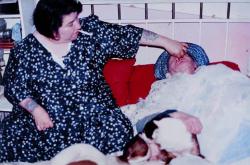
During this exhibition some of the works caused public outrage and despite the controversy, it attracted almost 3,000 visitors daily at the Royal Academy, making it one of the most popular exhibitions in its history. The New York Times wrote as following about the exhibition: ” What is so new about the art in ‘Sensation’?” curator Norman Rosenthal asks rhetorically. “The answer lies in the generation of artists’ totally new and radical attitude to realism, or rather to reality and real life itself.””
It seems one has to consider that artists are responsible for constructing environments, like performance art, which immerse the spectator or audience in a embodied experience by the 1960’s. (Gavin Butt introduction article in his book, After Criticism) If one looks at the YBA’s of the 1990s they are a group of much ‘hype’ but also not discussing or commenting on critique – making it difficult for any ‘privileged’ or ‘authoritative’ viewpoint.
I discuss with a friend who feels one cannot say that experience is the same. Our use of authority is in language linked to knowledge, mastery, certainty and truth. Gender, Race, Ethnicity and Culture are concepts with more than one definition – which I can also call an experience. In a way our identities have been formed by the outside due to the use of systems of classification, or categories or appearances, and only by sharing/questioning these experiences will we learn /understand /experience similarities and shared identities, which could be fixed or universal. Insisting on differences to have authority as the only truth solidifies a position that you are right and they are wrong – the other comes into play.
Can it be that by trying to work through this difficulty in dealing with differences that we discover some form of universal experience, namely that we all (universally) struggle with this double edged sword we call ‘Identity and Culture’? Love refers to (Love, 2005, 163)
According to biology of the human genome genetic variation is minute – and seemingly this is the part we are concerned with when we look at appearance. So does this mean that genetically we are universal – I do think so.
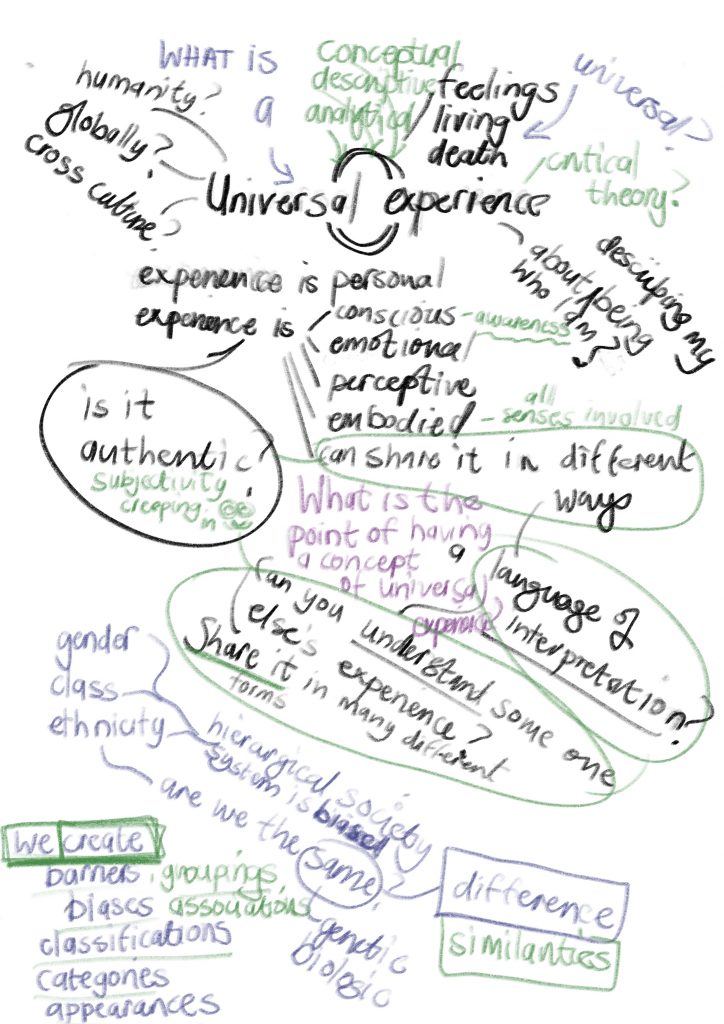
I looked at the Vietnamese film-maker and feminist critic Trinh T. Minh-ha who also analyses how it is possible to identify oneself according to a racial grouping. She resists simplistic identification and limiting racial definitions, using the discourse of deconstruction to undo the arguments of racial essentialism: as a need to rely on an ‘undisputed origin’ is prey to an obsessive fear: that of losing a connection . . . The real, nothing else than a code of representation does not (cannot) coincide with the lived or the performed. This is what Vine Deloria Jr accounts for when he exclaims: ‘not even Indians can relate themselves to this type of creature who, to anthropologists, is the “real” Indian.’
(Trinh T. Minh-ha 1989: 94)
in the video below I also get this contradiction between translating and knowing, which happens in language. It seems language as a construct gets in the way of a good experience of just having a cup of tea:).
Reading list
Love, Kate 2005 “The Experience Of Art As A Living Through Of Language.” After art criticism: New responses to Art and Performance. (2005)pp 156-175. Print.downloaded from OCA library https://ebookcentral.proquest.com/lib/ucreative-ebooks/reader.action?docID=350918&ppg=149
https://www.researchgate.net/publication/330397425_Tracey_Emin’s_Self_Portraiture
Searle, Adrian, 2002, Searle, “Me, Me, Me, Me,” The Guardian (London) Tuesday, April 22, 1997.
Wikipedia.org lehmannmaupin.com. 1 May 1999. Archived from the original on 6 May 2016. Retrieved online on 20 October 2020.
Reflecting on this exercise
I decided to come back to this exercise after my tutor sent me her review of this part. She wanted me to do discuss how my ideas above sit within my own practice. Critic of my work was experienced by me as follows – where are you? Will the artist please show up? I really have to find the place where I am comfortable – I do not think I am the ME, me, me, as Tracy Emin, but I am also not seeing myself as a wallflower – I think I am hesitant I fear the exposure. I prefer to see my work about myself as personal, but that I would hopefully grow from that place into an authentic painter.
I look at my material investigation into writing about my thoughts when I paint or draw. I consider how fragmented ideas become fragmented works – I constantly battle to finish a work, I have many works that are still Work In Progress – does it say something about my questions about a work being finished, good enough? Does is say something about not having delved into deeper layers behind the obvious? I am a late comer to art making and I am not even sure what is my practice – being a student has consumed most of my time around art in the last months. Do I get lost in reading and theory? I am confronted by lack of work to show as material evidence of me developing my skills as a painter – do have many fragments of attempts, but not a lot of developing taking place. Do I keep work physically around me as a constant reminder of this in-action? (my workplace is unorganised) Does above writing indicate how much I battle with my identity as thinking of myself as an artist. ( I created a website for my work, called, karenstanderart, but I is about a student and her work, it is not about an artist making or being and artist)
Below is a drawing I made after a visit to a museum of natural history in South Africa. This was inspired by an installation with dried specimens of butterflies placed in front of a photo of their natural veld habitat. I wanted to draw the image of freedom, yet it was ‘held’ captive in the installation, and it was dead species. A way we keep/curate things of beauty or curiosity? I love these white veined butterflies and their history as yearly migrators are very much part of my own experience of time. (they normally migrate around end December/early January in Southern Africa) I helped my husband to make a wooden frame and framed the drawing myself. I feel this is a look into the past of how and what I do – the study guide suggested that one look into own material work, and I want to draw from this as part of understanding myself within my own work practice. I worked on cheap butcher’s paper, as the drawing developed I got more involved in finishing the work and see it framed. I withheld an urge to start over on better paper. It stays a fragile monochrome study of a natural habitat. I could have done it much better had I planned to use etching paper and size the work better – it does not sit well in the frame. I used erasing to create monochrome butterflies as well as the grasses, to make it recede. I tried quick studies with gouache in my sketchbook as well as made a layer or gesso to paint and see the effect, but I prefer the drawing. I ignored to have a horizon line and feel the work is about the butterflies in the grass. It reminds me of Monet’s waterlily paintings in Orangerie – not in size, but the way I tried to get the viewer look at the butterflies in the grass, a moment as in a real life encounter with them in the veld, as they continuously move.
A small ‘painting’ was done of the same type of butterflies in my assignment painting. Can these works can be seen as part of that work? I can use this work and develop it into a much bigger drawing.
Exercise 3.3 Finding your voice
Are there other ways to find your ‘voice’ in your work other than drawing from personal identity? Can it be found for example through process, technical skill, or specialism?
Reflect in your learning log on your studio work to date and think what you would consider being your voice in the work.
A difficult thing to describe my own ‘voice’ in my work. I think my voice is investigative and curious about place and nature and significance of being and growing. Over the course tutors in Drawing and Painting have suggested and hinted to this almost ‘illusive’ hide-and seek thing I am trying to find inside and share on the outside. Does it show in my style of painting, in what I write, in my opinions? How real and authentic is it? Art can surely act as a voice – for the oppressed in many of the works I have looked at in the previous exercises , is that also the artists voice?
I agree with K Love that meaning and experience is attached to voice. For me it comes from a personal place, but it grows with following a certain process, developing certain skills or even specialising into one thing/practice. I know/recognise a DeKooning, a Van Gogh, a Pollock and a Hockney. In my first formal feedback my tutor referred to my personal voice as having a ‘good sense of where you are in context. Now focus on practice.’ She also said my thinking is complex and wondered how it would look in terms of making. I see this as an enquiry through praxis, which need to show how contex merge and synthesise. I like things found in the context of it being fragments/momentary, but also that they were displaced through certain actions and time. Collecting and gathering is my ‘thing’ to archiving ideas and exploration in time . I keep old magazines – in my current explorations in my studio I could use it to explore collage around collecting and curating. See my padlet at https://padlet.com/carolina5194071/tsjvhngt0mke78qp
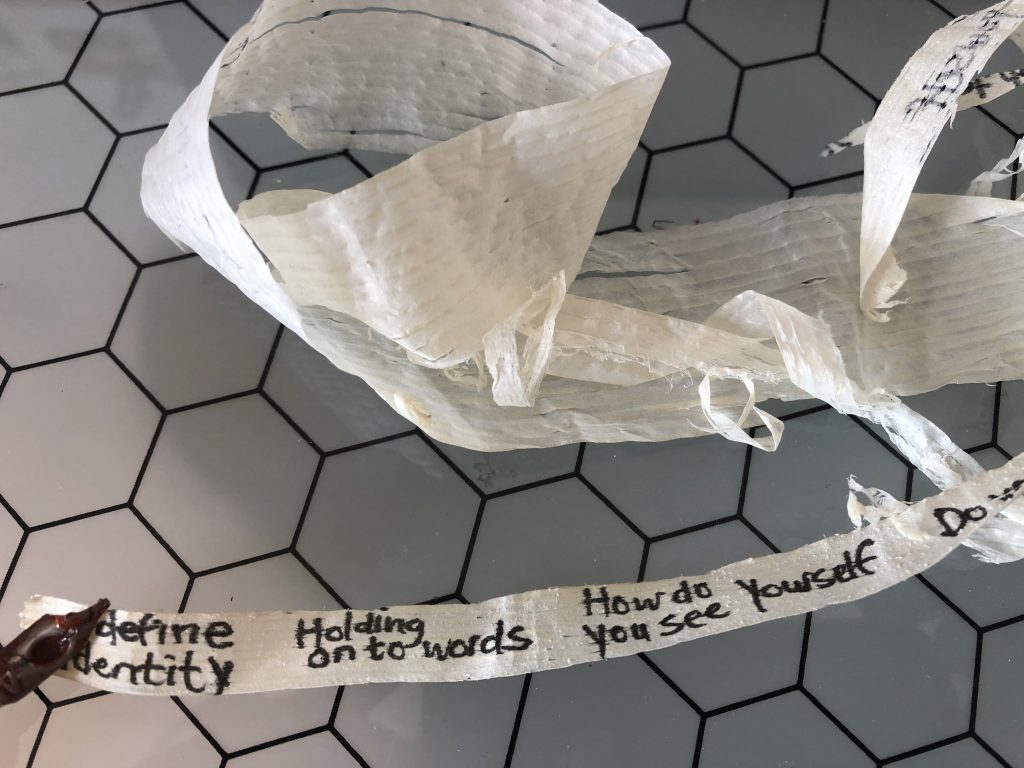
I am adding this after my discussions with my tutor. I focus on my use of fragments – as words in spoken/written language as well as memories of things. In a way it is about recognising how I sense and then how my brain distributes what I sense. In my practice I find I reach a place where I am unsure to continue and literally leave the work to come back later. I will add work to the Parallel project, extend the blog called Parallel Project Part 3.
Exercise 3.4: Thinking through the structure for the Parallel Project Exercise
I will discuss this on the blog called, Parallel project
REFLECTING ON THIS PART
I will discuss this on the blog called, Parallel project and have also started a Padlet for developing and brainstorming ideas
https://padlet.com/carolina5194071/t1pq4l04wmmq
My tutor suggested that I explore these ideas much further through material and material investigation – more experimentation with have to be shown.
Topic 2 Art, Experience and Language
3.5 The edge of language
If you accept that there is no ‘neutral’, authoritative position from which art can be judged, then what other ways are there to critically engage with it? Love describes two existing models:
- To conflate experience with authentic knowledge, which exists outside language (you have examined in topic 1 the problems that this model poses).
- Experience is always already in language if it is to be understood as experience. It seems that both of these models seem inadequate for the critical analysis of art. The alternative that Love proposes more accurately describes the experience of making work as an artist and engaging with it as a viewer. In this model, experience is somewhat unfixable and rather than something you ‘know’ or ‘understand’ it is something you roughly grasp the feeling of. It is ‘an approach to the world which I both recognized, and yet didn’t quite recognize, a space which was both in language but yet not quite in language, at the limit of language but unequivocally not beyond.’ (Love, 2005:169). Rather than dismiss this place at the edge of language that often describes an encounter with art, it could be explored as a valid mode of analysis, one that enables openness, fluidity and liveliness.
Find an artwork that you find difficult, but at the same time are drawn to and want to engage with in more depth. Remain open to this feeling of not knowing and rather than being frustrated that you have not understood the work or interpreted it adequately, create a map of your experience in your sketchbook of this encounter over a 30 min period. Begin with a description of everything you see in as much detail as possible, then chart everything that you think and feel, the connections you observe, which thoughts recur or evolve. Decide the ratio of the written and visual content of your map.
Before I start: I remember that my first encounter in front of a Van Gogh self portrait in the Museum Van Gogh was that of an awareness of colour and the brush stroke effect, his use of orange and blue – I said out loud, ‘ look how it comes together’, the guy (unknown to me, as I prefer these moments to be my own, visiting alone for first time) next to me looked at me as if I it was obvious, but did he not see what I saw —- look at it, it is genius and own technique! I felt like crying about the pain and struggle this artist worked under. A picture, a book about van Gogh, could not prepare me for this moment of awareness in front of this work.
I want to look at the series of work by Cy Twombly (1928-2011), called Untitled I -IX (9 works) which I saw a while ago and never really took action to know or understand more. I did not bother to learn more about the work or the artist at that stage, at that stage I was busy with Drawing 1. It was the last part of the exhibition, my husband was reminding me that we had to leave, but something was out of place for me – my own ‘mis understanding/not understanding.
I saw his work at the Louvre Abu Dhabi the first time in 2018 and was captured by the colours and physicality of of this painting/drawing, which mainly is doodle scribbles in white on blue ground and were linked to the sea – in this case the museum is on an island and the country has links to a maritime history. I made notes of the fact that this series of 8 canvases are part of a series that the artist called Notes from Salalah after the name of an area in the south of Oman in the Arabian Peninsula. This area is known in history for producing incense.
I believe I was mainly drawn by the ‘free from’ ideas the work represented to me – without any meaning or trying to interpret them, also not having much contex with regards to the painter and what he wanted to represent. Recently I have seen more of his works, started following an Instagram feed and most probably need to admit that when I saw these works did not bother to understand it. I presume these works would have followed his blackboard paintings – like extensions of that period? It was made much later in his life. I knew he was drawn to poetry and would use lines inserted in his works – but not sure of this process. What I am now thinking – is is about the hard work of writing a poem – was Twombly alluring to that? Having done the work on WH Auden and considering ‘that place’ from which a poem comes from, how fragments of words, a line, a sentence, can lead to making/creating. My own experience up to now, is very much alike – things happen, needs to happen at the right moment to spur me on.
Having read about Barthes in the previous part of this studies, I realized I need to find a connection between the painting and writing. I think about how important writing is in the Arabic culture. In the Muslim tradition art is mainly non-figurative and have unique character of geometric, arabesque, floral, and calligraphic patterns which reflect on their aspects of balance. The Arabic written language can be seen as art , I have looked when someone writes it in calligraphy and it is a thing of beauty- do I think the same if I look at our western writings, even the Chinese and Japanese letters are so exquisitely performed. I think it is great to think about the importance of language and language of art in this situation.
Calligraphy is a visual art related to writing. It is the design and execution of lettering with a broad-tipped instrument, brush, or other writing instrument. A contemporary calligraphic practice can be defined as “the art of giving form to signs in an expressive, harmonious, and skillful manner”. Wikipedia
I have since learnt that white and blue can be signs of the purity of the soul. Cy Twombly is an American who worked and stayed a long part of his life in a coastal town, Gaeta, near Rome, in Italy, which influenced his use of colour and light. I do not know that he has a relation to Salalah in Oman, which could connect the work with the Arabian culture in terms of place. Calligraphy is in my view very meticulous artform and focussed on beauty in the execution of the mark making. Below is an image of a Museum of the Future, currently under construction and being a 3d printed building, with a written poem on the building. I could not find the meaning of the Arabic on this building. I do believe it was written by the current ruler of Dubai, who is also a poet and writer.
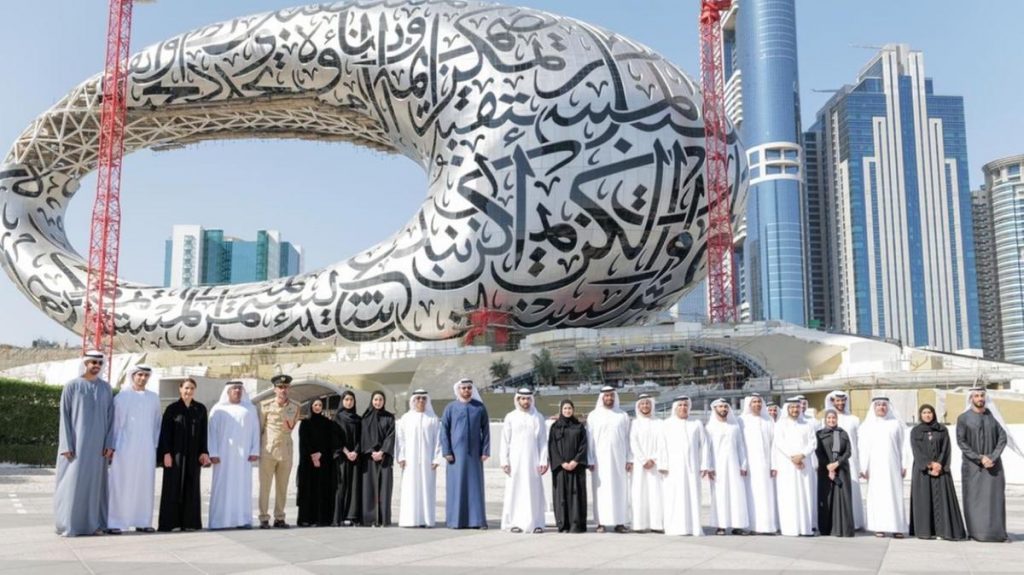
The white contrast with the blue colour bring the coolness which one can only experience when next to the coast. Looking at the work one is firstly confronted with the scale of the works and how you see his actions whilst painting the scribbles unto the blue ground. I love the colours and scale of the work – it reminds me of the seaside, wind blowing and the freshness of white linen and soft towels – something in the blue is more vibrant. When we came to live here in the UAE I was driven to the contrasting bright colours of the Arabian decorative things (fabric and lights) – it brought a warmth which is so different from the heat the sun gives in this desert landscape. It is these jewel colours that stayed with me and inspired my own life here.
I would imagine he worked with household and acrylic paints. The white paint is at times opaque and then watery in consistency – looks like drippings on some parts of the canvas. It also seems that he worked wet on wet in some areas. Why so many – could it be that this artist was trying to work on repetition and reflecting on mechanism, automatic writing (surrealism?) in his work process? I also feel almost overwhelmed by this process – is it because I interpret so much about the influence of abstract expressionists and the minimalists into this work. Was he sharing concerns about drawing and painting – I do know that he was not interested in popular culture and looked at Classical art, Greek Mythology, Egyptian sculpture, that he travalled to North Africa (Morocco) – paintings I have seen of him reminded me of Paul Klee and Kadinsky – they were more watery, but could also be marks and scribbles. I have a memory of Nini’s Painting I saw in an artbook I have, and think relates to nature.
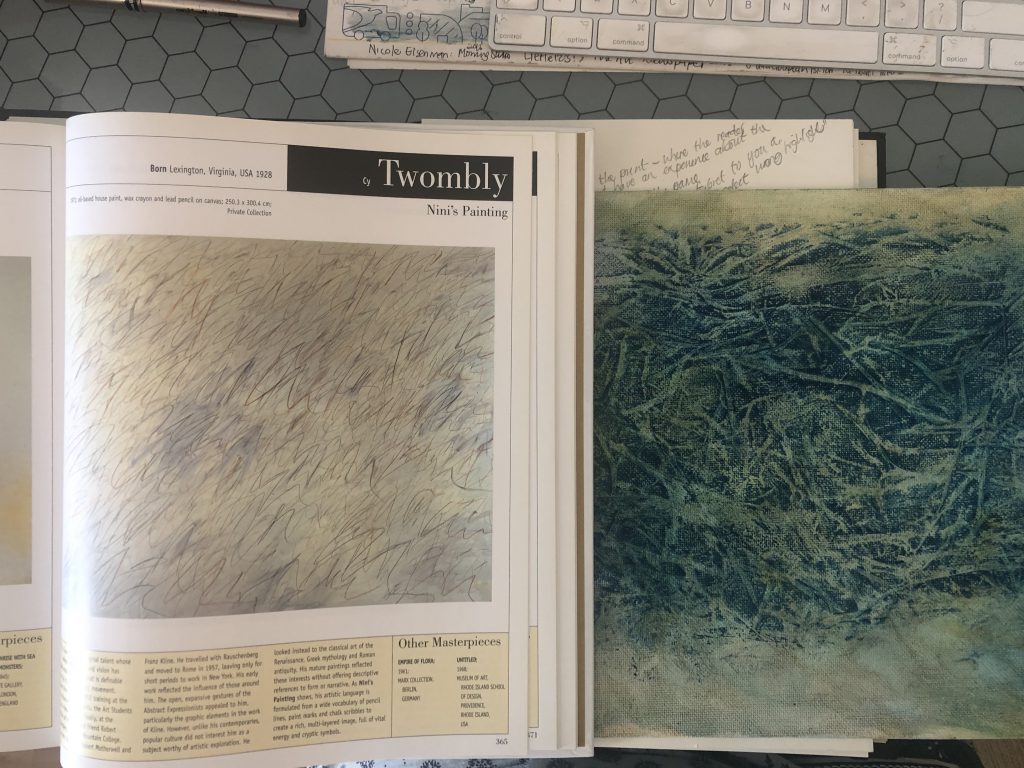
When I made the seagrass painting in the POP course it was an intuitive process – I could not really explain why – but had to do with an attempt to make an abstract representation of the fragile grasses I collected on the beach. I thought about ideas of abstraction, but wanted to stay grounded in nature – I would think I should look into bringing light into this work and learn from his work.
Reflecting on this exercise:
I think back to W Kentridge and how drawing it is part of his thinking, is this not what one finds in a Twombly painting? I feel the difference is that here is no figuration, but most probably expression of feeling. I had an old work, tried Cyanotype printing – was not a good outcome and decided I like the blue ground colour to try out a Twombly inspired writing experiment.
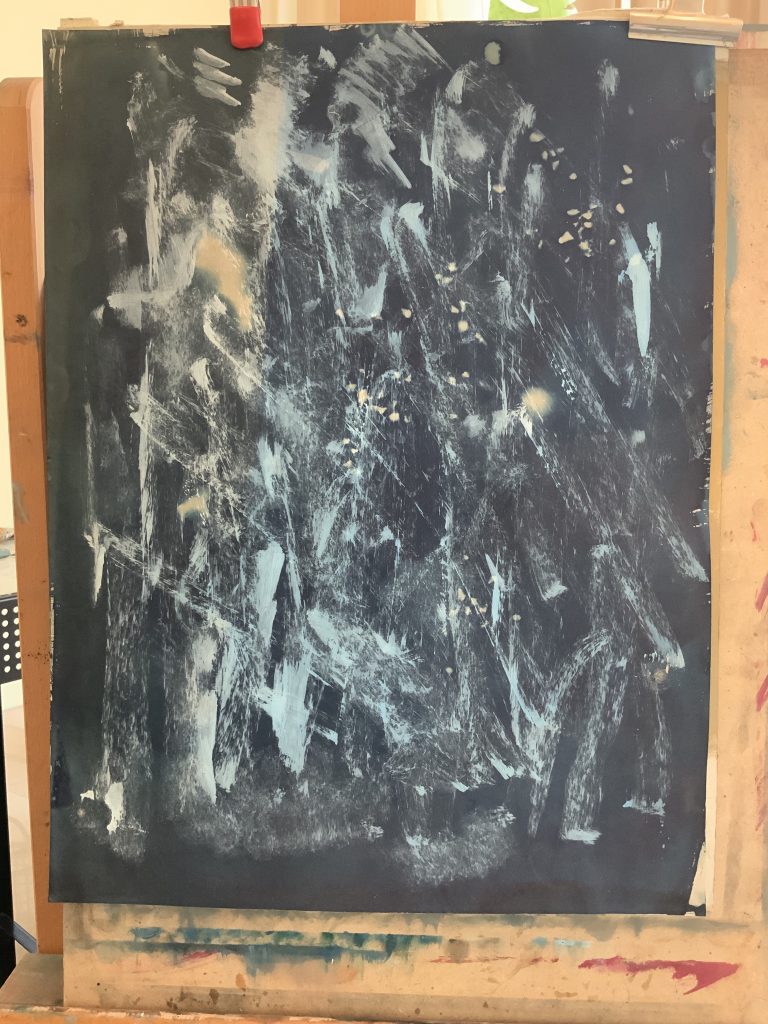
I used white drawing pastel to write – interesting, I started writing in ‘longhand’, which I do not see as my ‘neat’ or best handwriting, but feel it comes from repetitive learning to write in school, is also seems to be easier to draw compared to cursive writing – flow. Is the writing more about gesture than action?I feel I have learnt so much from this exercise, even if I have gone off the rails in a way! I am left handed and am so aware that in writing/painting/drawing I can erase or smudge – which with charcoal and pastels, could happen easily. Trying a sentence in cursive writing later in the work – I find that it is not so ‘concealed’ as the longhand style – I could easily read, after I went over it twice, but by the third layer it became more concealed.
“The art, skill, or manner of handwriting is called penmanship. Handwriting in which successive letters are joined is called cursive script. … Decorative handwriting (as well as the art of producing decorative handwriting) is called calligraphy.“
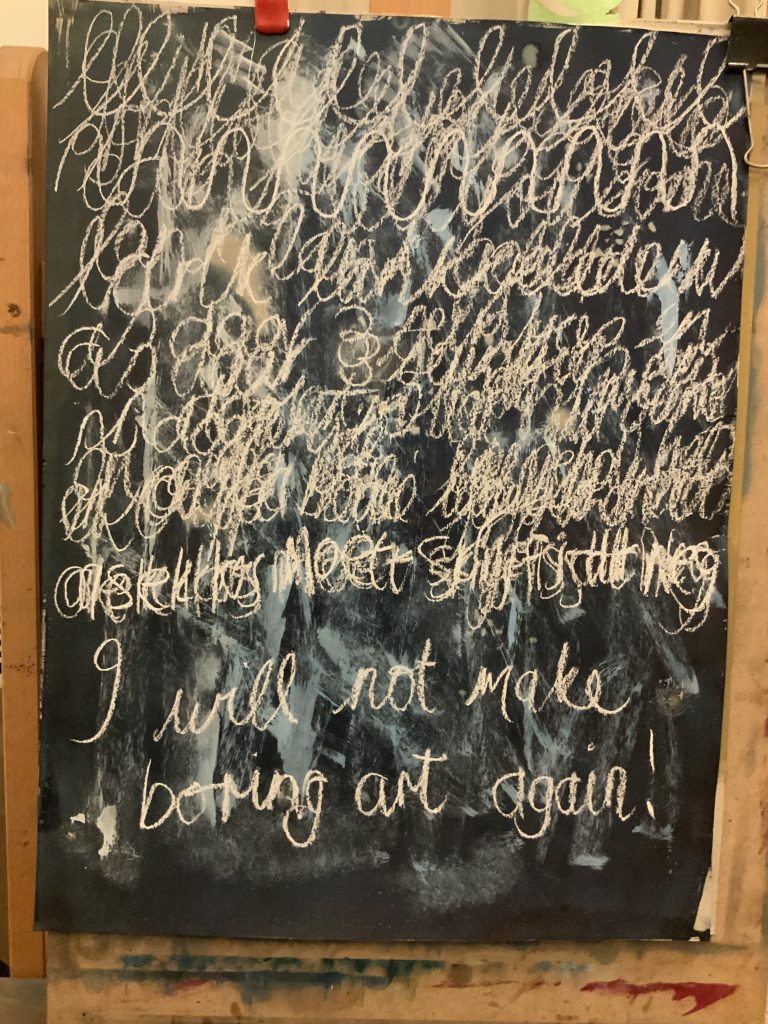
A google search produced very interesting material – here R Barthes is linked to Twombly. The following are copied from the blog site based on an essay by R Barthes on Cy Twombly (Dogma art.com), is seems that the mentioned essay was done for a catalogue raisonné of Twombly’s drawing Exhibition in 1979 at the Pompidou Centre, Paris.
Then I read this: ” TW, contrary to the venture of so many present-day painters, shows the gesture. We are not asked to see, to conceive, to savor the product, but to review, to identify, and, so to speak, to enjoy the movement which has ended up here.….
…Many of TW’s compositions suggest, it has been said, the scrawls of children. The child is the infant who does not speak; but the child who conducts TW’s hand already writes- he is a schoolboy: lined paper, colored pencils, ruler, repeated letters, little plumes of cross-hatching, like the smoke that comes out of the locomotive in children’s drawings….“
TW’s work is a kind of writing; it has some relation with calligraphy. Yet this relation is one neither of imitation nor of inspiration; a canvas by TW is only what we might call the allusive field of writing. TW alludes to writing ( as he often does, as well, to culture, through words: Virgil, Sesostris), and then goes off somewhere else. Where? Specifically, far away from calligraphy, i.e., from that formed, drawn, deliberate, shapely writing, which in the eighteen century was called a fine hand.
TW has his own way of saying that the essence of writing is neither a form nor a usage but only a gesture, the gesture which produces it by permitting it to linger: a blur, almost a blotch, a negligence…..
On certain surface of TW’s there is nothing written, and yet these surfaces seem to be the repository of all writing. Just as Chinese writing was born, we are told, from the tiny cracks of an overheated tortoiseshell, so what appears to be writing in TW’s work is born from the surface itself. No surface, wherever we consider it, is a virgin surface: everything is always, already, rough, discontinuous, unequal, set in motion by some accident: there is the texture of the paper, then the stains, the hatchings, the tracery of strokes, the diagrams, the words. At the end of this chain, writing loses its violence; what is imposed is not this writing or that, not even the Being of writing, it is the idea of a graphic texture: “for writing”, says TW’s work, as we might say elsewhere: “for talking”, “for eating”……
I bought a Kindle Book, Reading Cy Twombly: Poetry in Paint, by Mary Jacobus
Exercise 3.6 An experiment in writing
The art historian T.J. Clark visited the painting Landscape with a Man Killed by a Snake by Poussin regularly over a six-month period and kept a diary. This became the book: Clark, T, J. (2006) The Sight of Death. An experiment in Art Writing. New Haven: Yale University Press.
Read: Philips, A. (2006) ‘What do you think you are looking at?’ In: Theguardian.com 13.08.06 [online] At:
https://www.theguardian.com/books/2006/aug/13/art (Accessed on 07.06.18)
Choose one particular diary entry from the book to read. How would you compare this form of analysis to other forms that you are familiar with? Does it enable you to engage with the work in a new or different way? How might this affect the way that you approach the next artwork that you see? Summarise your thoughts in your learning log
The cover reads: Why do we keep returning to certain pictures? What is it we are looking for? How does our understanding of an image change over time? This investigates the nature of visual complexity, the capacity of certain images to sustain repeated attention, and how pictures respond and resist their viewers’ wishes. I could view parts of the book with Google books and are still giggling about an inscription where he says “kids with squeaking Nikes” were ‘taking over the room”. (p 39) and he was tired.

I am using 31 January and the paragraph on page 42-43. At this stage the writer is working on a poem about above artwork.
“Taking stock of this entry (and several of the previous ones), it occurs to me, not for the first time, that readers looking over my shoulder may find a touch of madness in them, or maybe pathos. I seem to be operating on the assumption that just pointing things out, in the case of a painting like Landscape with a Calm, can (and ought to) go on forever. I seem almost to be setting myself the task of recapitulating in words every move in Poussin’s process of manufacture, as opposed to describing the main lines of his end product. I have no ready answer to this. I know there is something excessive and maybe ludicrous, to entering this closely into someone else’s imagined world. But these diary entries are partly meant as an argument in favor of such entry. They are meant as an apology for (a glorification of) painting’s stasis and smallness and meticulousness – for the way a painter like Poussin does not know when to stop.“
I like the diary style – fragments of thoughts which is being built up over time. I like his questioning and thoughts to look at how the work influence him – he finds the materiality of the work and is not merely giving an account of what is happening in the painting. I do appreciate this sensitive style of writing. I can imagine that regular visits must bring new things forward and really starting to feel as if you are getting into the artist’s mind and world. One can imagine the scene, how light falls and what possible could have been the strong visual influences.
The critic of Philips in The Guardian is also refreshing. I do like the way he looks at writing about art, the looking the happens and how the experience is translated in this diary type entries. It does indicate how theoretical writing can become pretentious and – ‘without vision’. I would have considered to read the book after reading at his review.
In my own practice I want to consider using broken language as fragments. My tutor suggested that I investigate this more. She feels I am good at putting fragments together in written form, so I should play and investigate this by making work around these ideas.
Exercise 3.7 Storytelling
Watch the following discussion between John Berger and Susan Sontag:
Voices, To tell a Story [television programme online] Pres. Berger, Sontag Channel 4 UK (1983) 63 mins At:
http://www.channel4.com/programmes/voices/on-demand/811-007 (12/06/18)
How do you think the issues raised in it relate to making and engaging with art? Make two lists in your sketchbook: one detailing the aspects that art and literature share and the second describing how they differ.
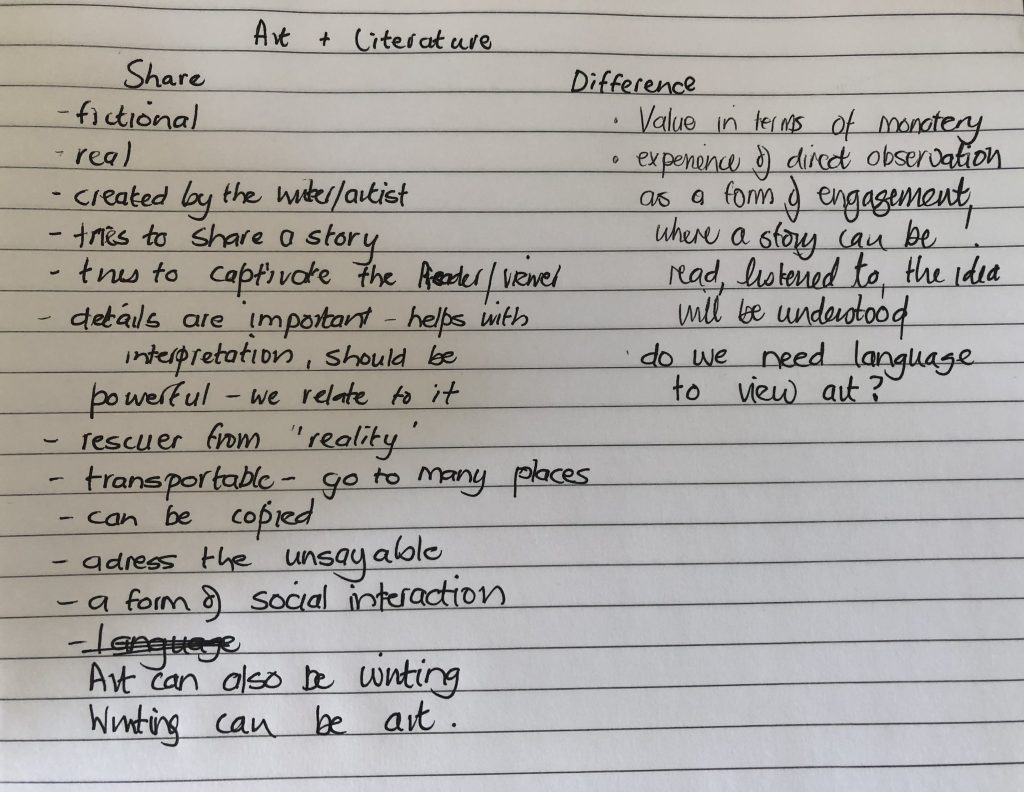
Below are my notes – I would like to keep it as fragments of how I listened to the discussion:
A very interesting discussion, loved how they listen to each other and share differences. Main ideas I take from storytelling and art is that both can be fictional and real, or part fictional and part real. The teller, like the artists creates this story, like a painter started painting after something happened which he/she feels is important to hear/reminded of and tries to keep the listener/viewer interested with this reaction. I do not think all painting is an reaction on?? The viewer has a need to hear stories about experiences, fantasy, taboos. Details shared in stories is important according to Sontag – as everything cannot be told, essential things are chosen by the story teller, illustrating a sensual effect in the story. Dream – is the telling of a dream, when you talk about it, then you interpret or find associations, which make the meaning we assign to stories. Detail should be powerful and thrilling. Berger feels that stories are always a rescuer against what he calls the ‘endless terrifying space that we life in’ – could art be seen at that – I do think so. Berger talks about readers in his village relating to a story, it gives meaning, it becomes coherent, it is given form – it contains a meaning. He relates as a writer to his audience – they relate to the experience, as they know it. Sontag differs with her relationship to her audience and think our imagination is hidden. She refers to fictional books she read, story telling according to her – yet the character and hallucinatory detail in the story that carried her imagination away – art of language. Meaning – establish the right of intensity of feelings – not necessary meaning, which ‘carries’ her away. Death – where one begins writing the story – its is possible, one can now read the life – it becomes readable to the storyteller/writer. The writer ‘reads’ across the death – life’s secretary. Life leads up to something/transformation – Sontag asks about this – he feels its full meaning is only understandable after life. Narration is about telling the story of a life – she asks him that his way is this. She feels there are more kinds of story telling – narration is strong due to depiction of character, action becomes immobilized , sometimes just a comment on… she things story telling has been expanded – fiction is not exhausted . We are expanding possibilities. When a story is printed – it is transportable, can go to many places, comment that needs to come in from the story teller – at the center and at the distance, on the horizon – is can be seen as the horizon. Place stories in that context where everybody lives – in the modern world, a subtle process – it co-exists in the world. You see the world as full of stories and the transmitters/vehicles of stories – I do not think the world is full of stories, the stories start with the writer – he is the originator. Stories are about looking back – becoming the viewer?
Essays and fiction are not very different – he sees himself not as very verbal – kind of model that he has seen or perceived which he feels is unsayable, exists and the struggle is always to try and re create that in words, 2/3 of the time, then the voices come, after the people has been established – are as close as possible to that non verbal /intuitive/sensing/
Sontag feels the activities are different – Same struggle yes. Verbal people (writing is re write should be better) Voice – language, she has a sentence – a dictation/ induction which she can revise through a process of invention. She feels loyal to certain modernist assumptions – art and literature, she feels he has abandoned. His recent stories are a different mode – have you changed? The experience of the under privilage is different – do you constitute yourself as a reporter of your experience. No – I believe in experience being shareable – imagination, capacity of empathy – a social creation which is imagination. Most novels are now disguised autobiographies – and then how to you have the right to write about one has not lived/seen. She feels that are more modes of story telling – movies – lots about more different things – which they do not understand or have experience of. He – the novelist is someone you wants to share something private and privileged. Sontag disagrees – Zola, Balzac – they saw the private and public was interrelated. Berger does not agree – the choices are no longer open to people – they have less choices. Because to the so much – we suffer from a crisis of imagination, its the choices we make.
Topic 3 The Speaking Object
“Paint is a cast made of the painter’s movements, a portrait of the painters’ body and thoughts.” James Elkins (Elkins, 2019, p5)
Reading point 2 Corpo Esteso/Expanded Body At:
http://www.esculenta.org/Corpo%20Esteso01.pdf (Accessed on 29.06.18)
New Materialism
Another aspect of making and viewing art that has been reconsidered in recent years is the relationship between humans and things. Modern Western culture commonly accepts the division and hierarchy between mind(life) and body(matter) advocated by the French philosopher René Descartes. This assumption supposes that there is a clear boundary between
the animate and the inanimate and it is human beings that have the ability to determine the destiny of the inanimate and to give meaning to it.
New materialists such as Jane Bennett and Bruno Latour, amongst others, question these claims and argue that matter is not dull, inert and passive, but in fact has power and agency (the capacity of an actor to act in a given environment). They re-examine the ideas of philosophers and writers such as Baruch Spinoza, Friedrich Nietzsche and Henry David Thoreau that had
been marginalised in the West in modern times. To blur the line between the animate and inanimate you would have had to have been superstitious or religious, but New Materialists put forward the case that things have the power to affect us, just as much as we do them, despite the fact that they are not conscious.
Materialism is seen as the theory or belief that nothing exists except matter and its movements and modifications…” How does this definition inform our understanding of “New Materialism”? I one consider the more recent advances in methods to view old paintings with like the spectroscopy, one could understand that this should lead to considerations on the role of materiality in the process of creation of a painting. Leonardo da Vinci developed images from stains on walls – was the fact that this could lead to new inventions of forms, (stimulate the artist when looking at it), not the ‘thing’ power of those shapes that brought the ideas forth? We also know he was an experimenter and inventor and worked on his own paint pigments, binders and varnishes. Some works even failed when he could not get the paint to adhere to the wall surface, (Walter, 2018: 106) This article also refer to artist Y Kline who developed his own blue, and Anish Kapoor, who acquired exclusive rights for Vantablack, which is made up of carbon nanotubes, having the same structure as that of coral, to give him a deep black which reflects less than 0.3% of visible light. According to this article Kapoor “stressed again to the public the fundamental role played by Materials Science during the process of artistic creation”
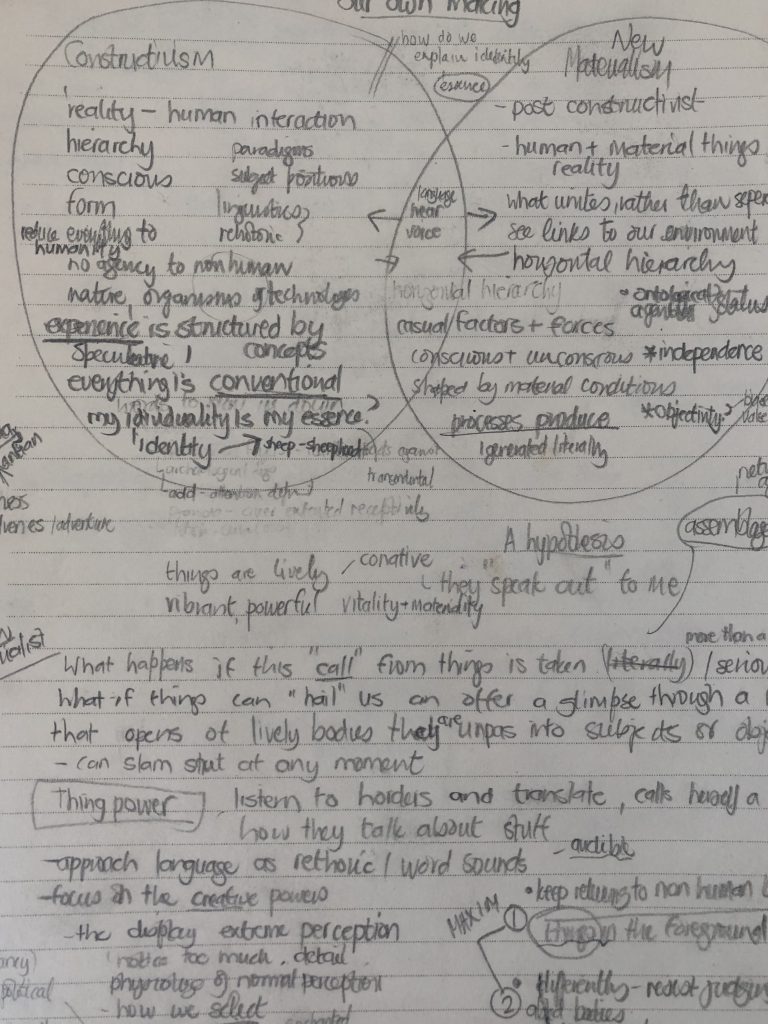
I started reading James Elkins’s book, What painting is, and in his (revised) preface (Elkins,2019 XIII) he writes he first publication came out too early, “and it chose the wrong interpretive language: but it belongs with post structural responses to materiality, he considers that in art history it is more about pictures or images than painting” – he assign this to a ‘certain fear of materiality’, and continues to write a few pages on Fear of Materiality (Elkins, 2019 XV – XXII) It seems Elkins wonders if Art History and historical interpretation sees the purely or merely physical as outside their domain – a point where writing becomes difficult. He reminds us that the studio is slow – “nothing might happen for long periods of time, even when something does take place, it may not be immediately clear what it is, or whether it might be important.” (Elkins 2019 XX) He writes about how meaning changes through slowness, it could seem dull, be painful, repetitive, dirty, and not very rewarding – there is not always flow/fluency. Jenny Saville calls it difficulty – the meaning and learning which comes from struggling. The struggle is part of getting something good and in the making. (Youtube, March 2018) Of getting the bodies right she used photographic images and talks about an interplay between artifice and reality, creating a reality of the photographic material, playing with artificial bodies in a sense.
Elkins writes about materiality that gets in the way of thinking as well as looking. In the first chapter, he wrote, “As the decades go by, a painter’s life becomes a life lived with oil paint, a story told in the thicknesses of oil. Any history of painting that does not take that obsession seriously is incomplete.” (Elkins, 2019:5)
It seems that the debate in contemporary philosophy is here within materialism itself. Above reading point referred to the work of Caretto and Spagna, which is an open research, analytical and non hierarchical, on the interdependent spaces that exist between human and non-human matter. They started a study into the the mineral world in 2008 at the Geological Reserve of Haute-Provence during a residency at the Art Centre of Digne. These two artists no longer ask the question of what is organic and what inorganic. Instead they experiment with the fine line that unites, rather than separates, matter’s different modes of being and man’s “organic” link with his environment. It seems that for Jane Bennett dualism is the problem. Mandy-Suzanne Wong (2015:4) wrote in the Evental Aesthetics magazine that there is a joke between composers and musicians that music making is ” the pushing and pushback of humans against sounds, of instruments against sounds, of papers and instruments against humans and sounds, and always, always vice versa.” She wrote that Morton Feldman, composer, spoke of composition as a collective act of human and nonhuman agents. She then continues to say that this reflection of Feldman on his artistic processes echos Jane Bennett’s vital (new) materials theory in which any ‘source of effects is —always an ontologically diverse assemblage of energies and bodies “acting on each other ‘in competition and confederations”(2015:5-6) Bennett says that things are not merely objects. they are vivid entities – each thin is more in inself than what is is for us.
The ‘nonhuman’ here is not limited to material ‘entities’, but also enrols forces, systems, processes, including
‘animals, affectivity, bodies, organic and geophysical systems, materiality or technologies’
138 Helen Frankenthaler invented stain painting using unprimed canvas.
Stains are capable of stimulating the discovery of new forms and thus generating unanticipated compositions in paintings.
Elkins, James, 2019. What Painting Is, Second Edition, Routledge, first edition published 1999.
Walter, Philippe, de Viguerie Laurence 2018. Materials science challenges in paintings. Nature Materials, Nature Publishing Group, 2018, 17 (2), pp.106-109. ff10.1038/nmat5070ff. ffhal-02405484f Accessed on 11 October 2020
Wong, Mandy-Suzanne Introductory Editorial: Towards a Vital Materialist Aesthetics, p 4 -16 Evental Esthetics, Vol 3, No3 (2015)
Jenny Saville research:Presented in partnership with English Heritage, “Visions of the Self: Rembrandt and Now,” was on view at Gagosian, Grosvenor Hill, London, from April 12–May 18, 2019: http://on.gagosian.com/SLnKxvP
Exercise 3.8 Things
Think about how your own relationship with things and the material world is shaped. How much is influenced by your work in the studio, family, peers, cultural beliefs, environmental issues, or what you read? Has your experience in the studio changed your relationship to the material world? Draw a diagram in your sketchbook showing how your beliefs connect and interact with each other.
Thinking about the discussion above supports the idea that matter, embodiment and materiality are integral to the art making process; it is interesting to think about how my work is influenced outside of me, that is not just about me as a primary active agent of the process. The artist as the body is connected with the materiality when the process of artmaking is enacted. Is this what the exercise is leaning towards? I am thinking of the expected writing and reflecting on/about thoughts one has during the making, using my computer as my ‘writer’ and main research source, other than books, search engines, pdf’s, online journals, SCRIBD, Kindle and Apps like Padlet, a WordPress Blog and Zoom meetings with student/study groups. I have learnt that artmaking can become an enquiry into. Language and sound do not have physical presence, but I can use it in art. I also think that having quiet times in my studio gives me opportunities to observe, reflect, react through intuition and enjoy moments of transcendence by exploring the unknown, became more important during this course. Things, in my mind are, what we brought into existence – by developing ideas, being innovative, learning from our ancestors and adapting to our environment – we used a universal thing, language, to assign value and meaning these things.
I recently looked at images of the The Great Chain of Being ( Aristotle’s Scala Naturae) which, according to Wikipedia, ” is a hierarchical structure of all matter and life, thought (intentional use?) later in medieval Christianity to have been decreed by God. The chain starts with God and progresses downward to angels, humans, animals, plants, and minerals.” I put this here as a reminder of the hegemony of hierarchy and its continuous use of power, assumptions, abuse, exploitation accordingly… my list can go on. Ridiculous to think that men ranked just below angels, who ranked below God …but women ranked somewhere with above lion. (see illustration on right, below) I prefer to accept science which talks about interconnectedness and illustrating this with a tree and branches stretching in many directions. I am concerned with human hubris and disconnect with the other.
I consider that things are always changing because it is inherently dynamic. I see my surrounding world becoming more divided and almost not willing to consider compromise and working for a communal good and considering the damage done to our planet, animals and each other. I was also influenced by reading Eastern Philosophy as well as the Franciscan religious ideas – I question dualism. A life changing reading was Eastern Mind, Western Body by Anodea Judith – which my husband and I listened together on Audible/Kindle books. I am living more aware with regards our consumption and usage of plastics, natural resources and made some changes in my life to live a more conscious life with regards to recycling, buying less consumables. Thinking about Chakras, and how using breathing, meditation, visualization techniques as ideas or feelings, does not feel right, as I believe there is a stronger force which influence my physical and spiritual being.
I feel concerned about the decline of biodiversity in our natural world and the part our materialism and ideas on consumption, man versus nature disconnect, development and individuality impacts on this. I am also concerned with our disconnect from our natural world. Thinking about these concerns as nonhuman – climate, wars, resources, genocide, racism – as humans we need to look at forces of climate, geological, ecological, perspective.
This takes me to the ‘things’ I want to paint – nature connections and disconnectedness; individuality versus interconnectedness in society and culture.
Exercise 3.9 Attraction
Think about the material you work with in the studio (this can include paint, digital media, etc) and/or the material world that you might respond to in your work, are there particular things, qualities, features that you are drawn to? Make a list in your sketchbook of what these are. Do you notice any patterns in the types of things you are attracted to?
The forms of Natural things – stones, plants, trees, rocks and mountains, water flowing, waves of the sea, wind and clouds, fabrics with texture, music, particularly violin and piano and people around me. I would like to do some figurative work of my own family. I started with family portraits, to be continued and finished, the grandchildren and wifes still to do. It was easier to finish my husband’s painting, even though I use photo images, him being physically with me – I can validate ideas and nuances. I found that with my kids being to far away, I lost the focus to continue.
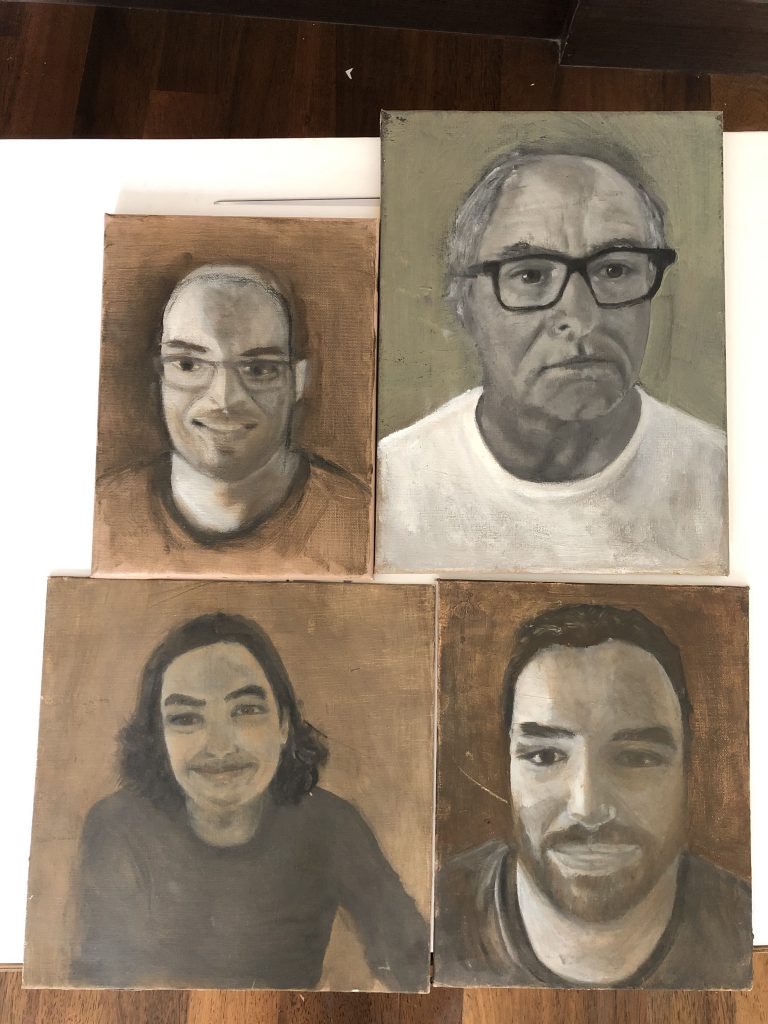
Qualities that I am drawn to:
Paint textures and layers with oil, liquin and OMS – using bigger brushes, also work soft with small brushes. I have come to understand that there is mostly a form of randomness at work with the materials – I presume the longer I work with them, the more I could attempt to ‘control’ this – this happens with a background – I start mostly with a ground, but as the work continues I want to add a different background and I find this as a scary route – things can go, and do go wrong. I learn about fluidity by using more OMS, patience, as I have to wait before I start working again – as the background stays wet for a while.
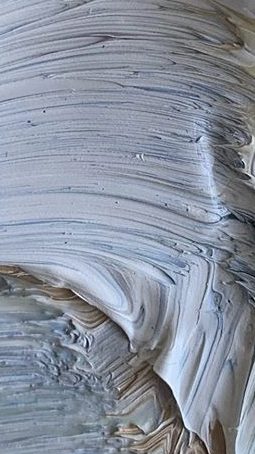
The artist is contemplating how much she loves the paint that was left on her palette after she finished an underpainting on a panel. I can relate to well to this – I wrote the following comment: ‘Me to –once saw how an artist made sculptures out of his dried palette scrapings, I added it to a layered self portrait. The wet palette is amazing materialized art …I think….our footprints in our working process. This made me think about materiality that happens whilst working and building up a work into form when it is figurative or representative of a thing – “the inside of the painting” (Jenny Saville interview).
I would like to paint more self portraits and onto faces in general. I decided to visit 2 Youtube videos of Jenny Saville I saw on how she learnt from Rembrandt in her “Visions of the self’ work and Life through a Microscope.
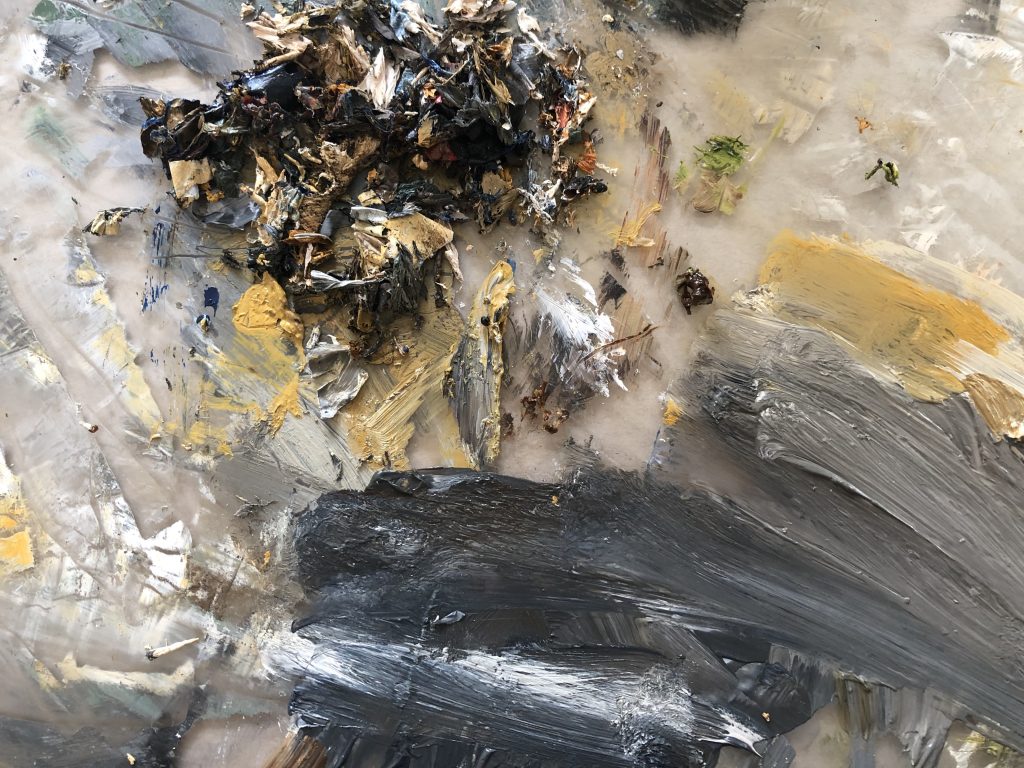
Mark making and drawing with charcoal is also what I love – the change that can take place my smearing/erasing – soft feel. I think there is also a form of exploring with the media which I like – more forgiving? Could it be that paint threatens me more?
Below is a drawing I made on found coral. I posted it on Instagram. I had to enquire if it was ok to pick up ‘dead’ pieces of coral on the beach. I would like to add this in a curiosity cabinet of found things on the beach. It also reminded my that I used to work a lot with pastels, and should get back into that material enquiry.
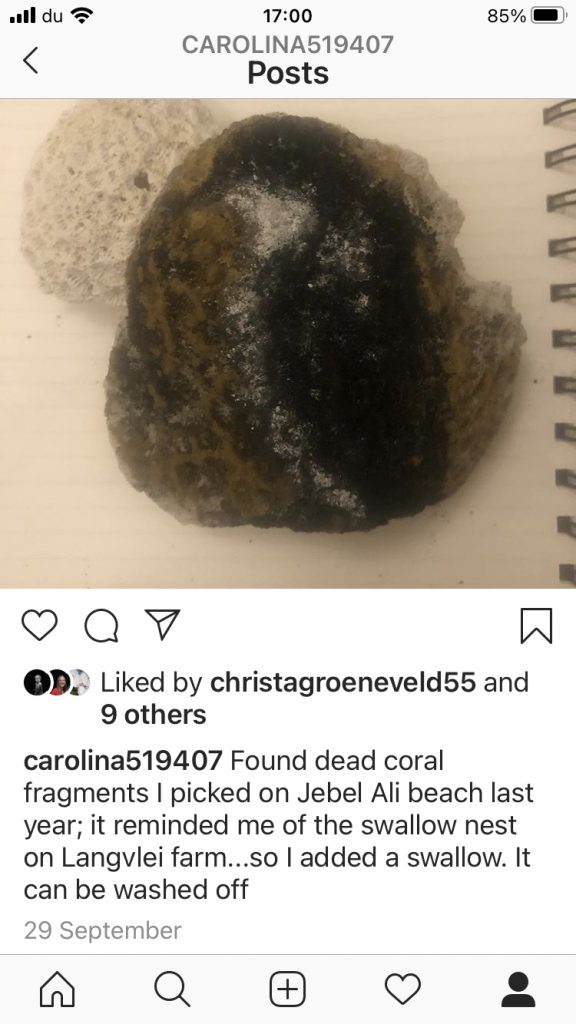
I would like to experiment with scale – small and very large.
I added the following thoughts and work after my tutor’s formal feedback:
My walking is a yearning to move and experience life outside my own working space – I take my senses there to be ‘contaminated’ and challenged in how I can draw or paint through this experience. I consider the other and seek to connect. Today I wondered if I paint with my Right hand…..can I show myself searching without judging or fear of failure?
I laid down some lines and mark making of possible walking routes within the area we life (fenced in security compound, Jebel Ali, Dubai). My right hand first followed the familiar ‘routes’ by attempting to stay on the lines I set out as the space. When the ‘other hand’ (right) started following its the routes, I realized my walking thoughts are coming back……(when I walk daily I attempt to spend at least between 30 -40 min outside and cover between 3 -5km)
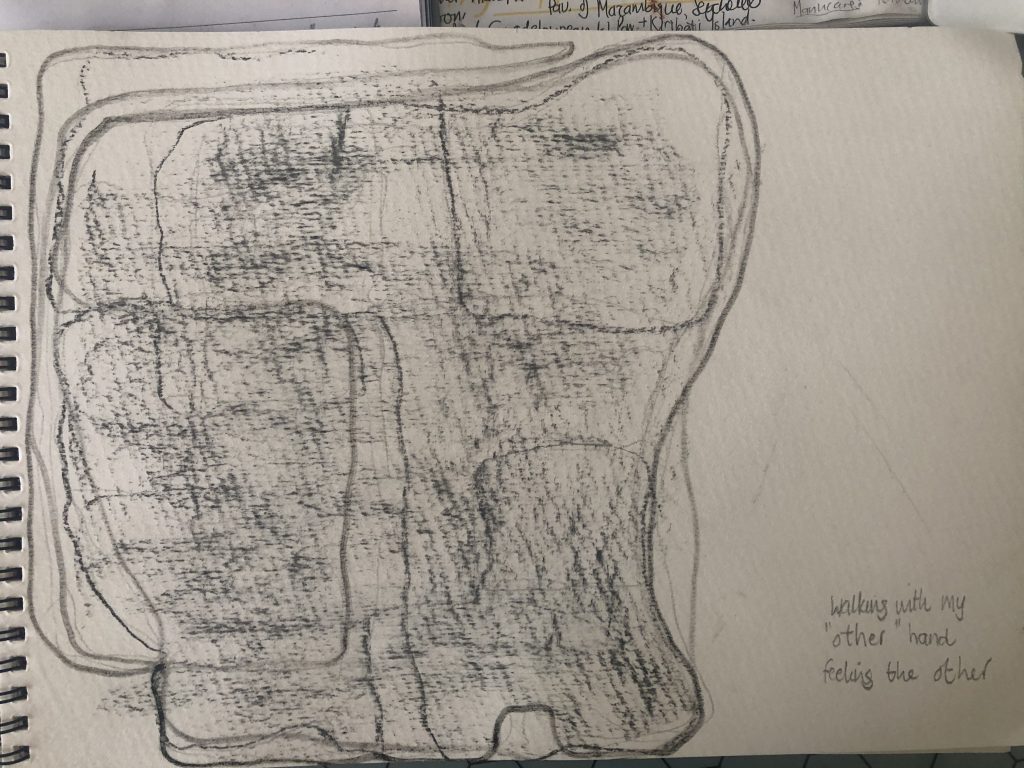
How far have I gone? How long have I been walking? Am I walking fast enough to have good exercise? Shall I go outside the compound and try the sand/desert road? I wish I could walk along the beach – I do not like this feeling of staying inside – I think I should run a while, My heart is beating faster, that’s good. I love to hear the birds – the sun is setting – I enjoy being here. It can be just a blur of thoughts which can weigh heavy on me – that voice that accuse and judge.
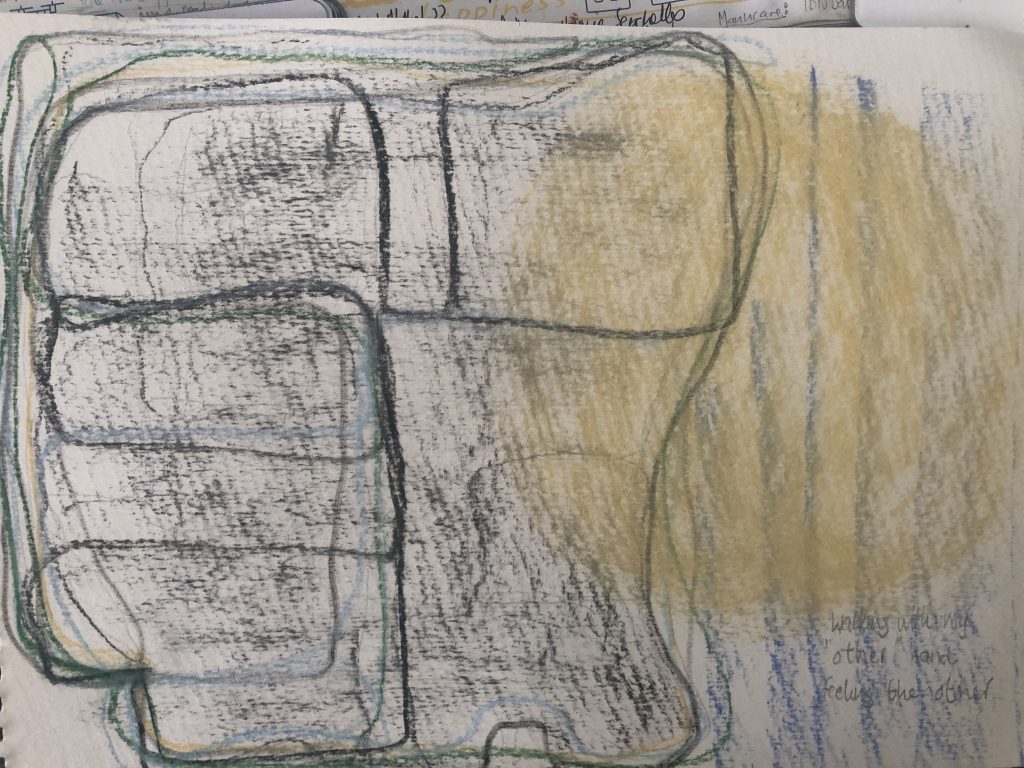
I added some ink marks and drew onto it with charcoal. I was thinking of the sun, the birds and the fence around my walking route. Looking at what I did and thinking how to push this further – I use colour , I make blocks of colour – I make a grid of walking lines. I am trying out my ‘other’ hand. When will I consider to paint with the other hand? Can I be brave enough to go there, after all it is just lines and moving. Something is familiar – my mind knows the route – my hand follows my mind. I decided to fix the drawing with a fixative and push it further.
Enjoying the movement of charcoal on the surface – a flat landscape of lines within a space, which started off as my drawing book, but now outside.
I created bodies behind the fence – having covered and erased some walking lines and colour to bring out abstract forms. A continuous process of exploring, like walking, taking me to places and seeing fresh.
What attracted me? the unknown, the pushing onwards without judgement to reach a connected making, but also a deep need to connect to a place of practice. Lines, broken, curved, becoming my identifying process with walking and my experience of feeling of being restricted and not showing up. With mark making exploring these feelings of being interconnected with the outside – fences I put up around myself and the viewer, fences I feel I need to break down, fences I want to ignore, but paradoxically also fences around me to keep me/us safe from other ‘things’ created around us. My environment is shaped not just by what I see or experience – it is controlled as a containment for people and things to move around, to develop, to work, to exploit and to conserve.
